Synology RS422+ NAS Review – The Compact Ryzen Rackmount
Synology has really been hitting the enterprise and high-end business market hard of late! With the brand clearly making moves to try and occupy a place in the highest hybrid cloud and service level storage providers, some have been concerned with Synology’s continued commitment to the home, prosumer and SMB. Therefore, many users were relieved to see the release of a new 1U prosumer/SMB in the brand’s Rackstation series, the Synology RS422+ NAS. This new 4-Bay rackmount server changes familiar staples of this scale of solution from Synology that make comparisons between the RS422+ and the RS419 or RS820+ very difficult, as this system arrives with better base hardware than those two options, but also has a few upgrade and scalability hurdles that make it a pinch less future proof for some users. Indeed, the RS422+ rackstation is a notably different kind of Synology NAS. Let’s sink our teeth into this rather compact embedded Ryzen rackmount and see whether it deserves your data.
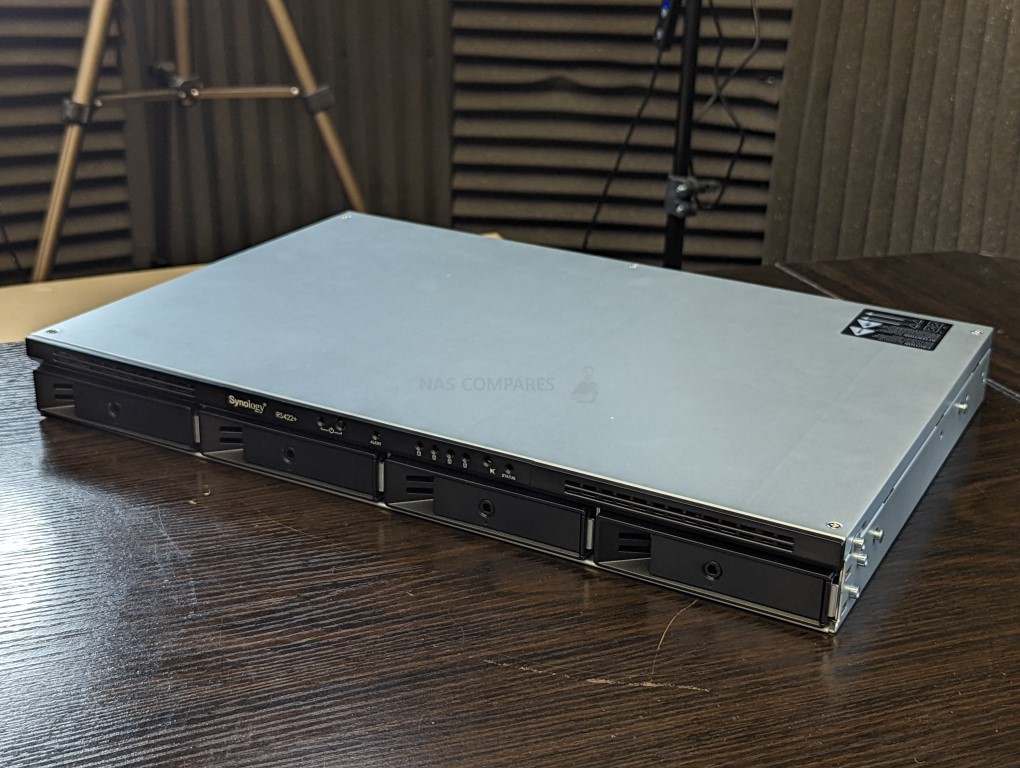
Synology RS422+ NAS Review – Quick Conclusion
What Synology has produced in the RS422+ Rackstation NAS is an intriguing middle ground between their more cost-effective ARM-based rackmount solutions and their more expensive scalable and upgradable servers. On the face of it, you are getting a tremendously compact but capable 1U 4-Bay rackmount server that, as soon as you factor in the included DSM software and services, is very good value for businesses that want to move their data out of 3rd party cloud and into something they have full control over. Additionally, that CPU (though a fraction divisive when compared previously vs Intel chips in the desktop DS1522+) makes more sense here in this more affordable Rackstation solution. The lack of NVMe M.2 SSD slots, fixed 2GB memory and lack off rails I am less keen on here (and I am still a little on the fence about the way they have pursued 10GbE upgrades in this system) but you are still getting a very well built and small scale NAS solution here and Synology have found a good price point here for this complete solution. Additionally, the fact that Synology has not been so restrictive on HDD use in this system than in more enterprise solutions in 2022 is welcoming too, though they are still taking an odd stance on some drives nonetheless. Ultimately, I can recommend the Synology RS422+ Rackstation NAS to smaller business users, though looking for a compact and very easy-to-deploy NAS solution for surveillance, central business storage, additional backup layers and for DSM as a whole. Though multimedia users might want to give it a miss.
| Where to Buy a Product | |||
|
|
    
|

|
VISIT RETAILER ➤ |
 |
    
|

|
VISIT RETAILER ➤ |
 |
    
|

|
VISIT RETAILER ➤ |
 |
    
|

|
VISIT RETAILER ➤ |
Synology RS422+ NAS Review – Packaging
The first thing that struck me when I saw the Synology RS422+ NAS was how small the external box was. When you hear ‘rackmount’, your brain automatically thinks ‘big, awkward, noisy’. However, in the case of the RS422+, I was genuinely surprised at the scale of the box it arrived inside.
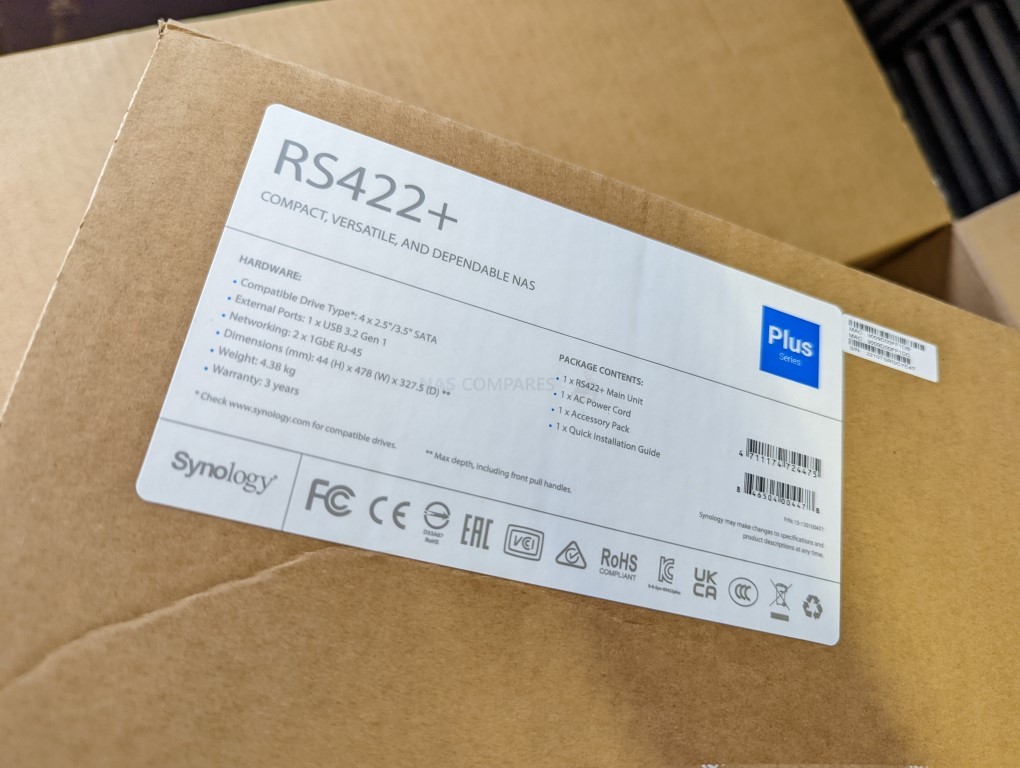
The unit arrives in the usual Synology packaging, 2 layers of cardboard and surrounded by hard foam for protection from shock damage and motion in transit. Synology has been increasing its range of more compact solutions in its portfolio for a number of years now (more commonly referred to as ‘half depth’), but still maintains the high level of protection that is afforded to them in transit. The unit is completely held in the rigid foam and the accessories pack, though a touch light on contents) in safely nestled inside.

Laying the contents of the RS422+ kit out on the desk shows that there is not a tremendous amount of contents to feast our eyes on. There is the NAS, screws for 2.5″/3.5″ media, details on the 3yr warranty, ethernet cables, first-time setup instructions, optional system handles and a mains power cable.
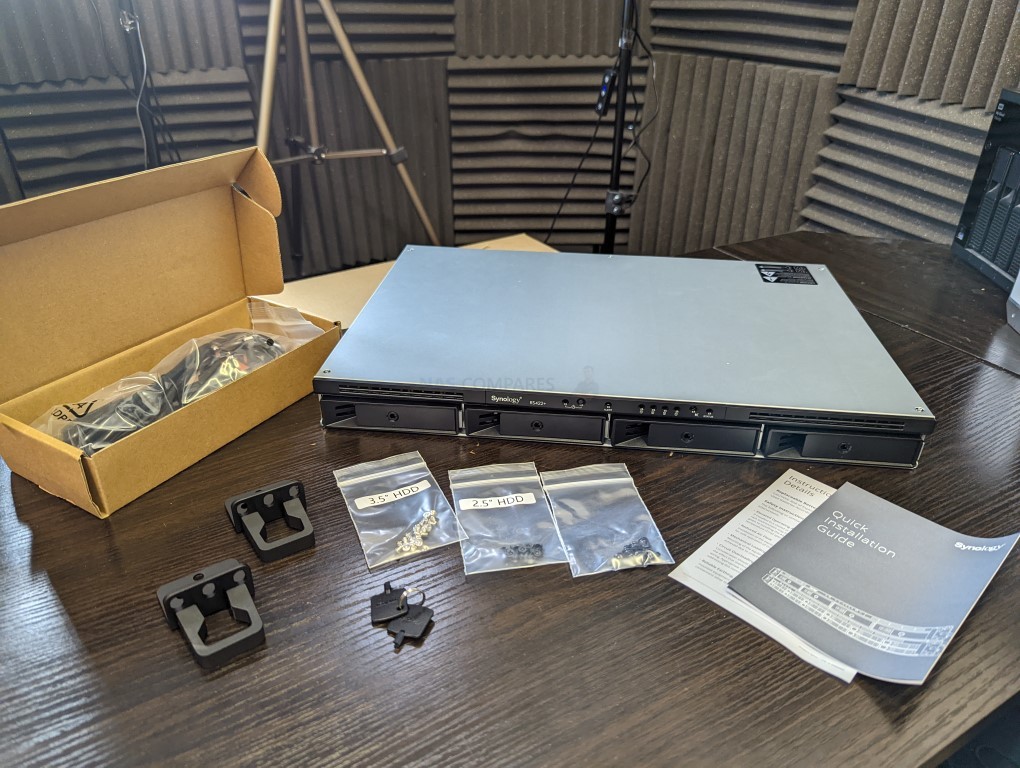
Although I am still a little surprised that Synology never include rail kits with their rackmounts by default (which might be a bit of a time/ease-of-access advantage if you use this in a full-depth rack cabinet that has standard depth rackmounts already installed alongside it), they do include the optional handles that allow you to slide the RS422+ in and out. Though I can definitely see alot of users considering installing this system outside of a classical rack cabinet setting, thanks to it’s small scale chassis. So perhaps in the case of half-depth rackmounts (especially in 1U) making rail kits options makes a little more sense.
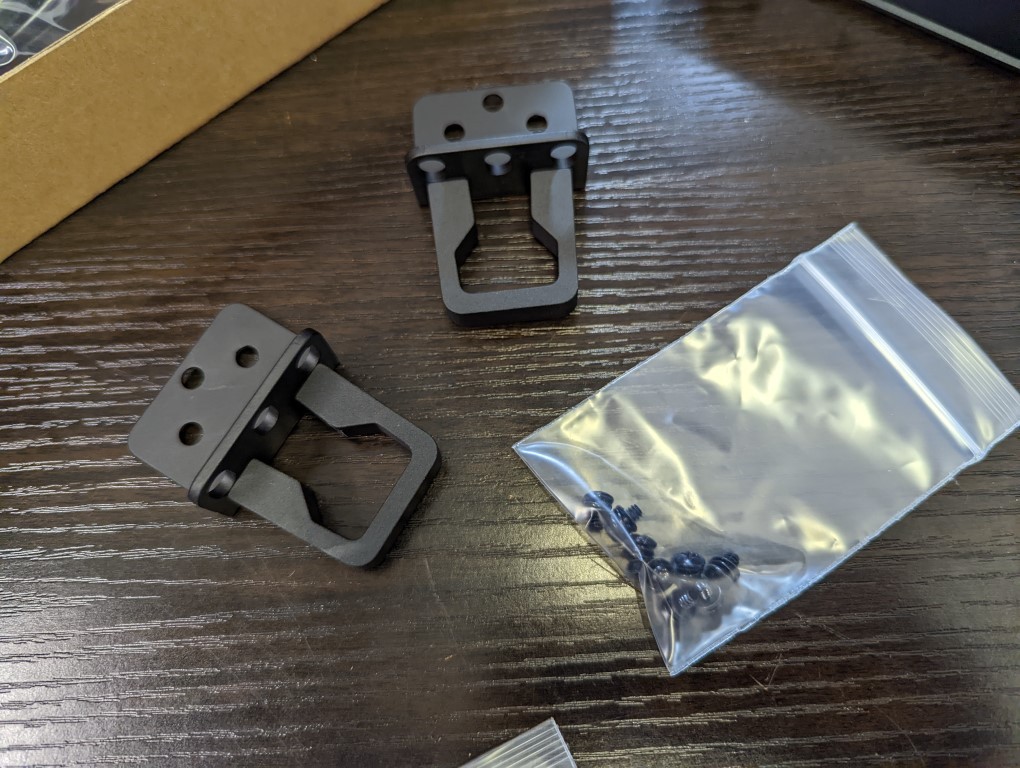
The ethernet cable included with the system is Cat 5e, which given that this system is 1GbE by default is perfectly fine. Overall this is a fairly standard and safe accessory kit that will give you pretty much everything (aside from media, obviously) that you will need to get this system up and running quickly. The protection and presentation of the system is as AAA+ as always from Synology and their high-class branding/image continues to set it apart from box shifters. However, it’s what is on the inside that counts! Let’s discuss the design of the Synology RS422+ Rackstation NAS.
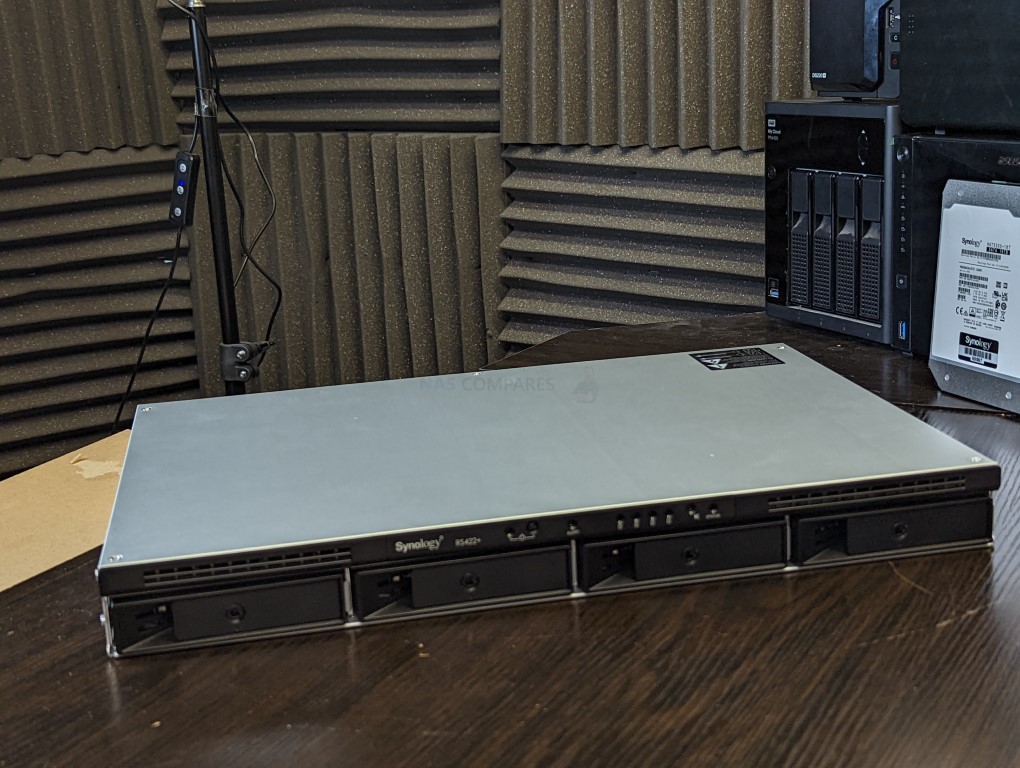
Synology RS422+ NAS Review – Design
This 1U Rackmount chassis features 4 bays of storage on the front, as well as an additional ventilation cavity above the HDD bays. Rackmount devices will almost always use a more horizontal means of internal ventilation, allowing air to pass through the system in this controlled, single-path fashion. The complete chassis is metal, with a plastic front panel.

Each of the bays can support a 3.5″/2.5″ drive, connecting to an internal combined SATA+Power connector. Though this system does not feature M.2 NVMe SSD bays internally, you can still occupy one or more of the main bays with SSDs and still use this feature. However, with only 4 bays available and no support of expansions (RX418), it would be a little fruitless. The RS422+ also supports Synology’s flexible RAID system, Synology Hybrid RAID (SHR), so mixing drive capacities is an option on day 1 or day 1000 increasing storage gradually if needed. There is also the support of traditional and more rigid RAID types, such as RAID 1, 5 and 6, so it’s good to have the choice.
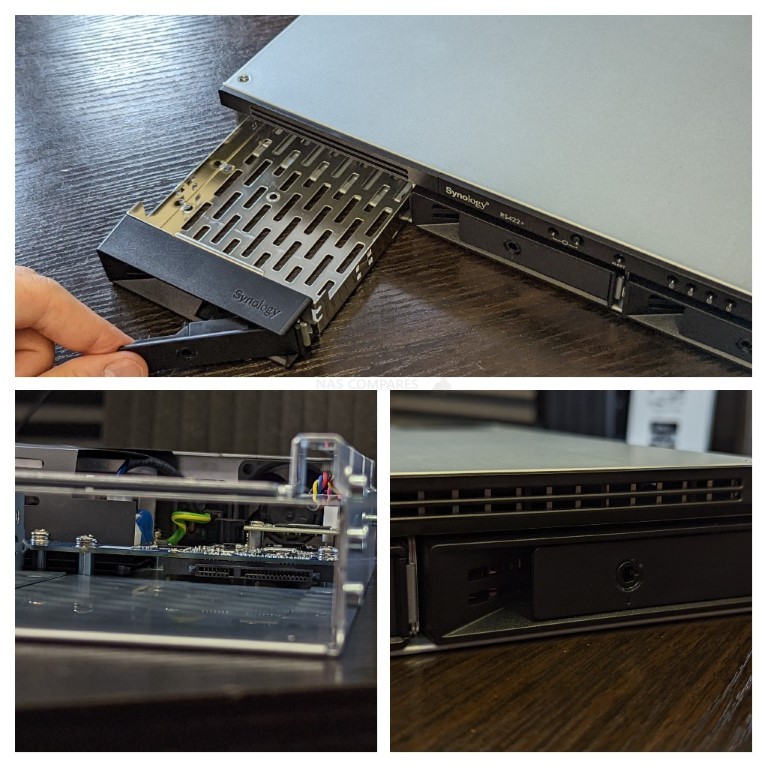
It is worth remembering though that Synology has been a tad more selective about the HDDs and SSDs that they have put on the RS422+’s compatibility than in previous releases in this series. They are not as strict as those of the 22 XS+ series or high capacity solutions that only seemingly support Synology storage media, but there are omissions such as WD Red and Red Pro drives that will lead to many querying their absence. These drives will likely work, but DSM 7.1 will likely highlight that they are not on the compatibility list and recommend their replacement (with an amber alert notification present).
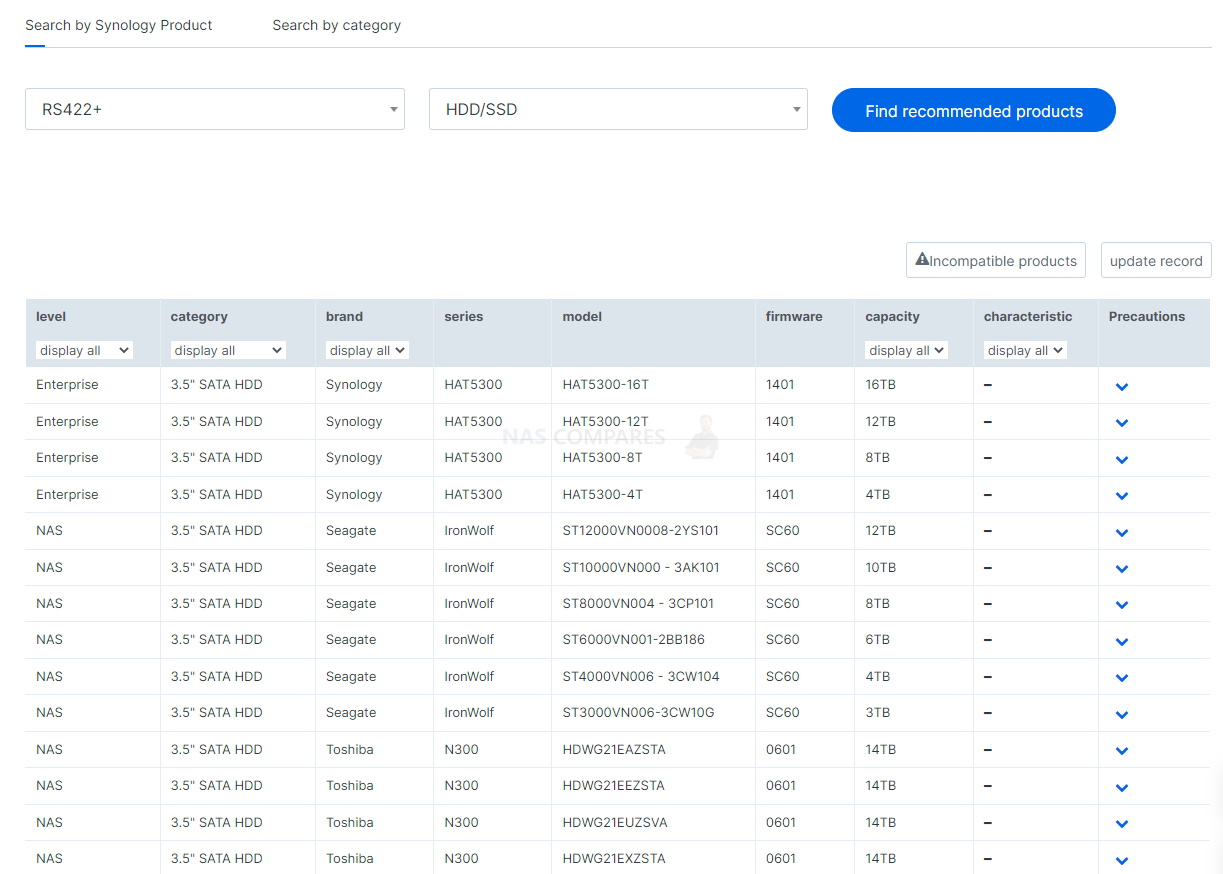
The trays inside the RS422+ NAS are metal, lockable (with keys included in the accessories kit) and have screw holes for installing media very easily. This system also supports hot-swapping (i.e. removing/adding drives whilst the system is on, though never remove a drive from an existing RAID pool), Hot spares (initialized drives that sit and wait for use in RAID re-builds) and Storage Manager in DSM also has the support of a FAST RAID Rebuild option. This is a feature that, in the event of a drive failure, the RAID rebuild will only rebuild the data on the areas of the disk where it was before (as opposed to checking and verifying even the empty spaces bit by bit) and the areas that had no data are simply zero’d out.
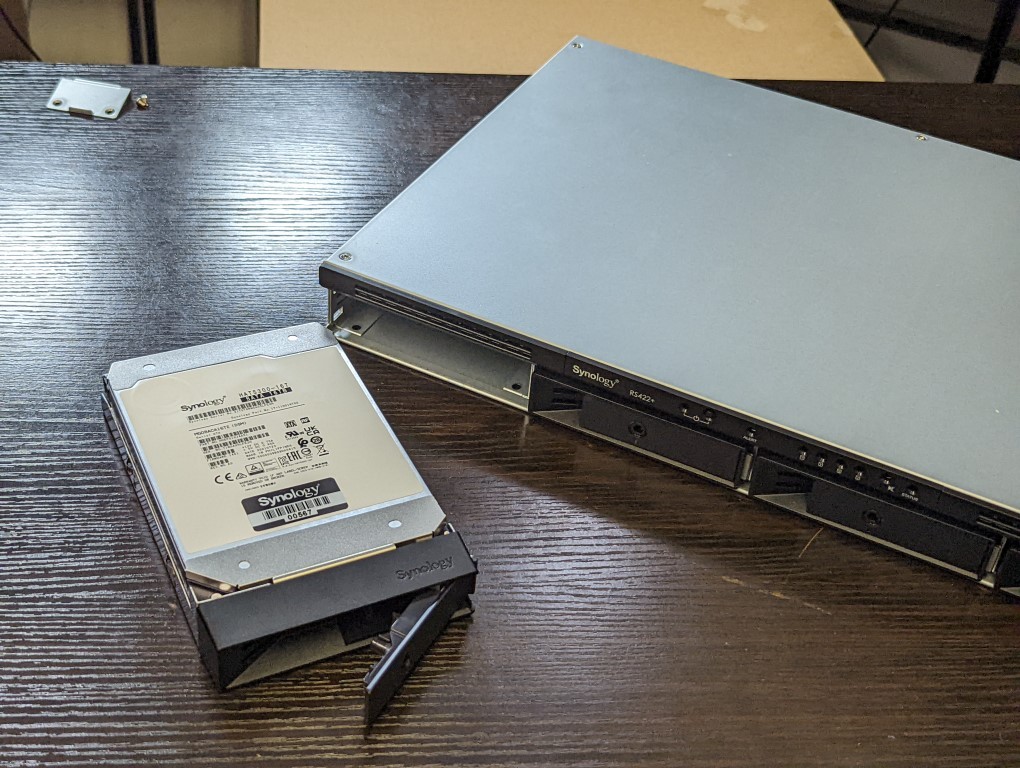
The front of the RS422+ lacks any LCD panel and instead features multiple LEDs that denote the system activity (network health, drive access, system status, etc). For such a small profile rackmount ANS, this will be more than sufficient to get an idea of how the system is operating at a glance. The RS422+ lacks any KVM access or direct interface without a 3rd party client device, but this has always been how Synology have designed their systems on the whole.
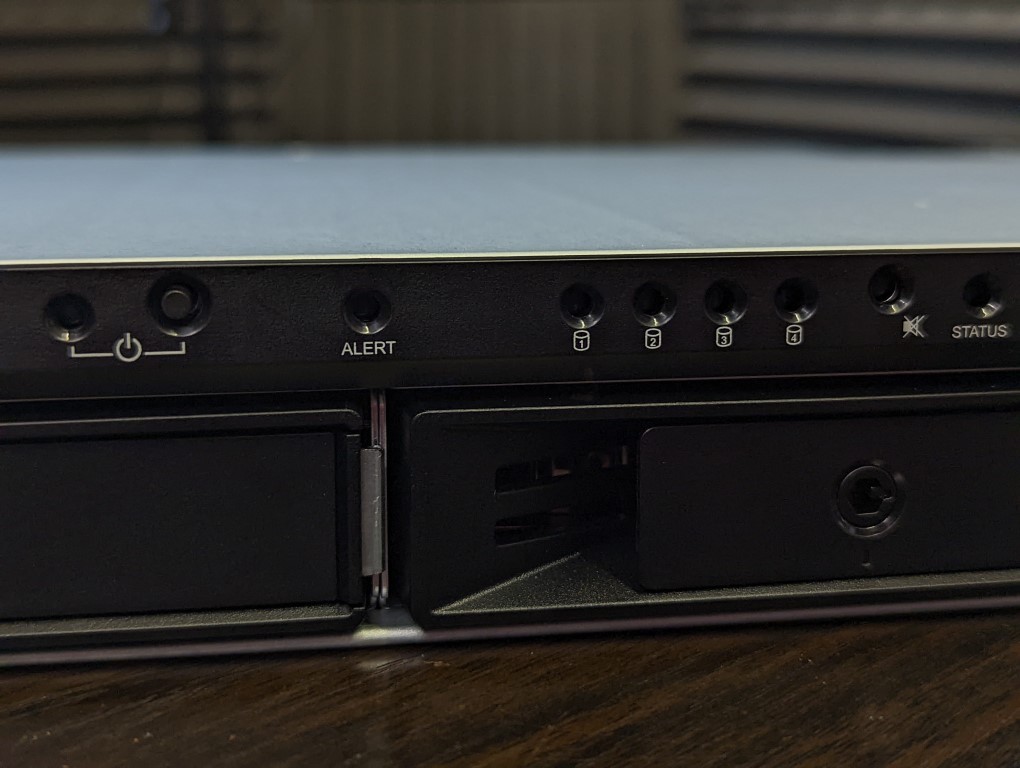
One thing that is very unique to rackmount NAS from Synology that you NEVER find on any desktop system is the inclusion of a mute button. Now, this button is designed for when the system starts beeping to alert the end-user/on-site-techie that something is amiss. These alerts can be customized to cover everything from serious stuff such as a RAID drive failure, network disconnection, system resource overuse or substantial rise in temperature. However, perhaps because of the enterprise and/or rackmount nature of the device, these rackmount systems feature an extra option to switch off these audio alerts. I have never quite understood this, as rackmount servers are all too often in a dedicated area of a building (server room, cabinet, cupboard home lab) because they tend to make more noise in operation 24×7. Whereas desktop NAS servers are all too often in the same room as people working. So, both in terms of proximity to the noise and convenience of quickly disabling the noise without entering via a browser/app GUI, it would make so, SO much more sense to have them on a desktop. Still, nice to have it here, I have just always wondered about that.
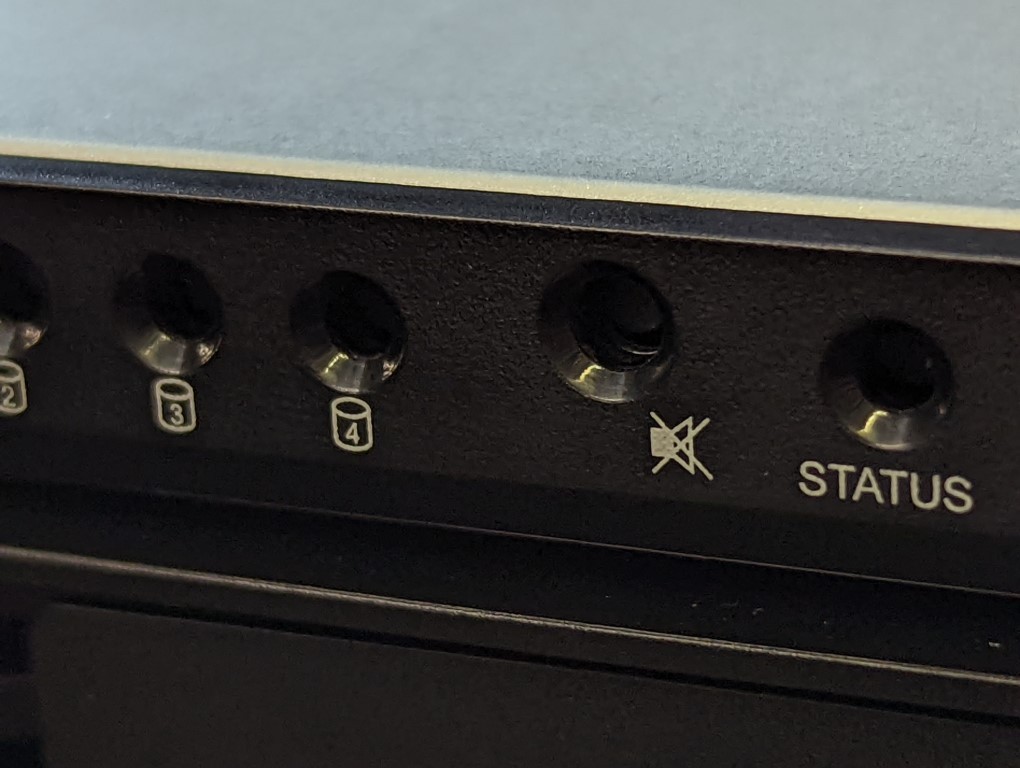
As mentioned earlier, you can attach handles to the front of the RS422+ to allow for easier removal from a rack cabinet for maintenance. It would have been nice for Synology to include rails with the server, but ah well. Attachment of the handles takes barely a couple of minutes and they feel nice and sturdy.
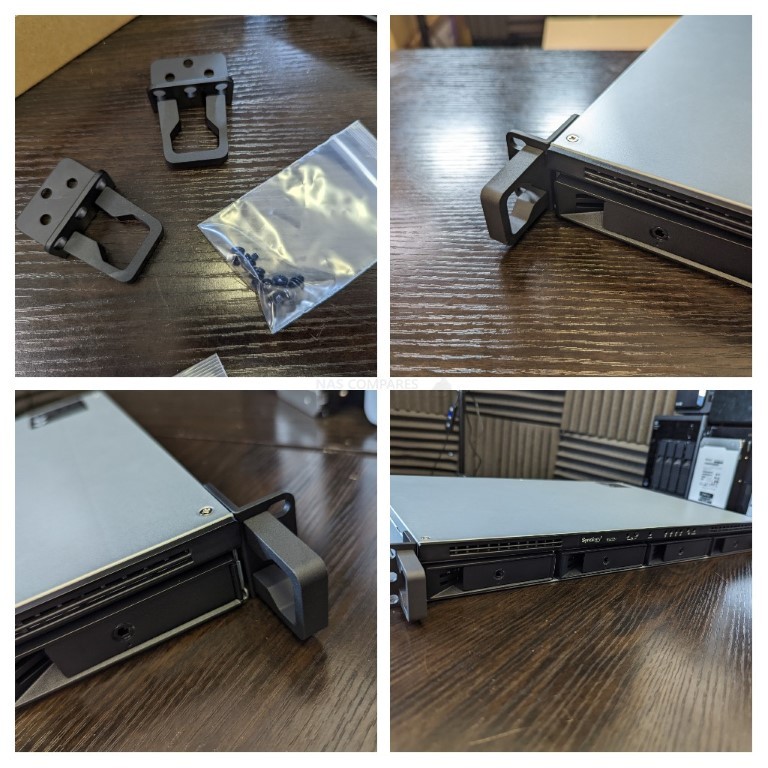
Overall, the design of the Synology RS422+ is of an expected high quality. There has been little or no change in this chassis compared with the older gen 1U rackmounts, but that is not a bad thing – if it’s ain’t broke, don’t fix it etc. The choices by Synology with regard to storage media are a little less transparent than some might like, but at least there is a wider degree of storage media supported on this system than many of the higher-end business products in the 2022 releases so far. Let’s discuss the connectivity of the Synology RS422+ Rackstation NAS, as we have an interesting mix of stuff to cover.
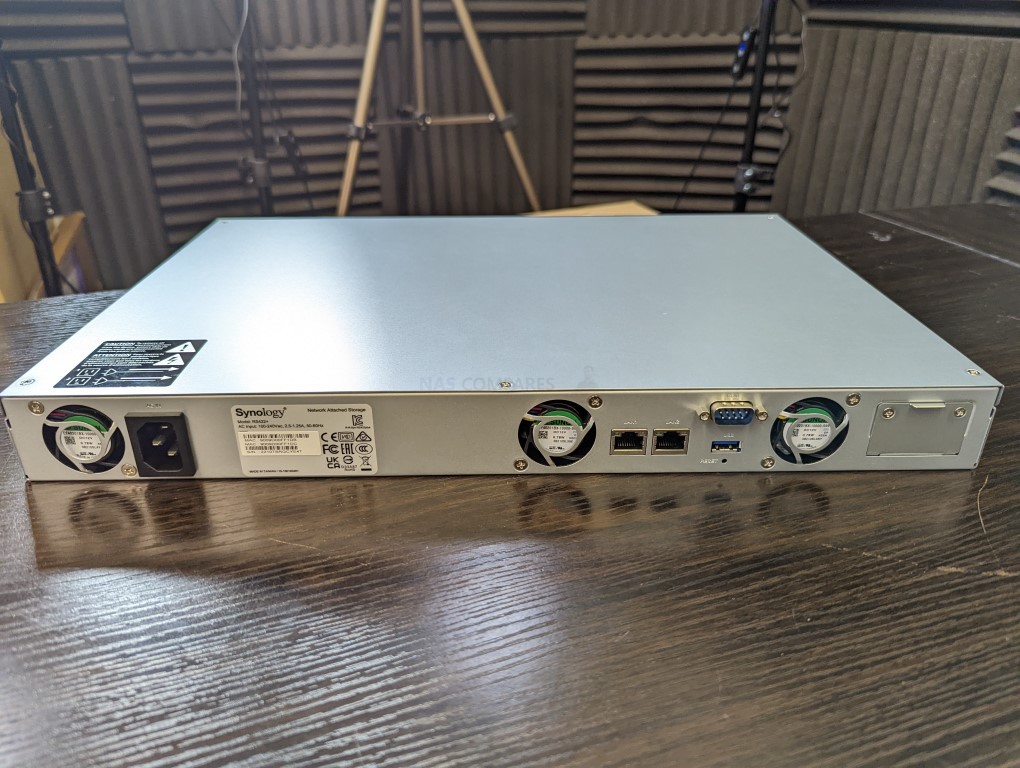
Synology RS422+ NAS Review – Ports and Connections
Rackmount servers have always been among the most desirable when it comes to business, largely down to generally higher hardware inside, greater network connectivity and increased expandability (unsurprisingly, given modern businesses are the ones producing the most data). Now Synology is no stranger to this, even in 1U rackmount form, but in spite of this the RS422+ is possibly one of the least scalable and upgradable rackmount solutions that the brand has ever introduced into the plus tier of it’s rackstation series. That isn’t to say that the RS422+ doesn’t;t have some solid hardware inside and out, it is just noticeable more ‘lower glass ceiling’ than almost all of their current rackstation solutions in 2020/2021/2022. The available connections on the rear of the system are (for the most part) exactly what you would expect, comparable to most other rackstation solutions.
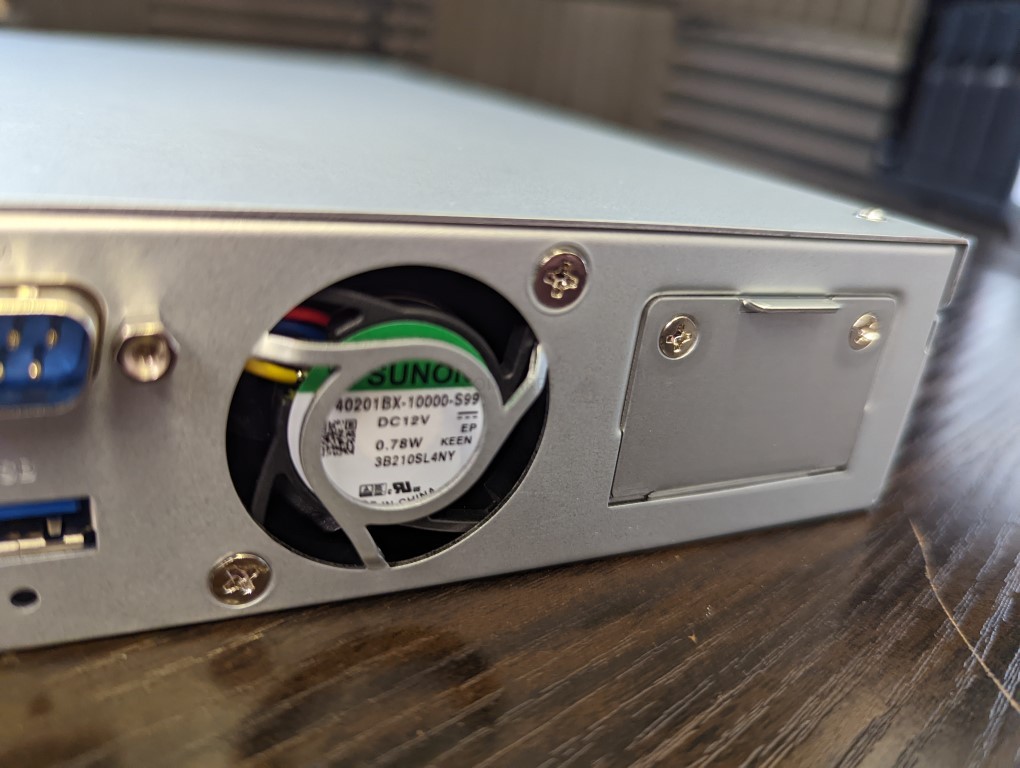
Unlike some of the bigger/scalable solutions, the RS422+ does not feature a redundant PSU option (i.e. an RP version, such as the RS822RP+ or RS2422RP+), though it DOES support Synology High Availability (SHA) to sync two RS422+ NAS’ together in an Active/Passive failover dynamic. What it has in its petite rack chassis is a single modest 100W internal PSU that Synology reports (when fully populated with HAT5300-16T HDDs) power usage of 37.93 W (in access) 13.43 W (when in standby/hibernation). That is an impressively low power consumption for this 4 Bay, especially when you factor in that AMD embedded Ryzen 64bit x86 processor. What about noise?
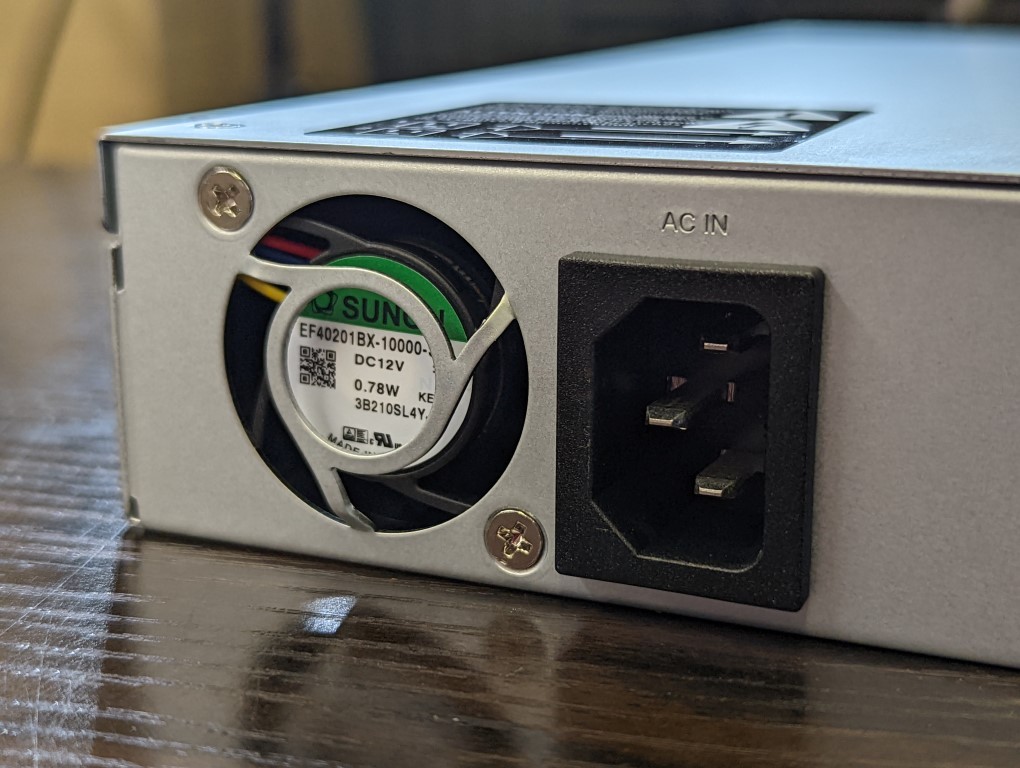
Well, that’s another of the classic rackmount associations that the RS422+ manages to counter – it’s actually quite a quiet rackmount NAS. Obviously, it is noisier than a 4-bay desktop equivalent (having metal trays, a metal chassis and technically three fans doesn’t help) but with Synology measuring the system at 28.5 dB(A) when in full population with Synology media and in active use, that is a fraction of other rackmounts out there. Alot of that comes down to the petite design, 1U height and single PSU frame. But regardless, that is a surprisingly quiet rackmount.
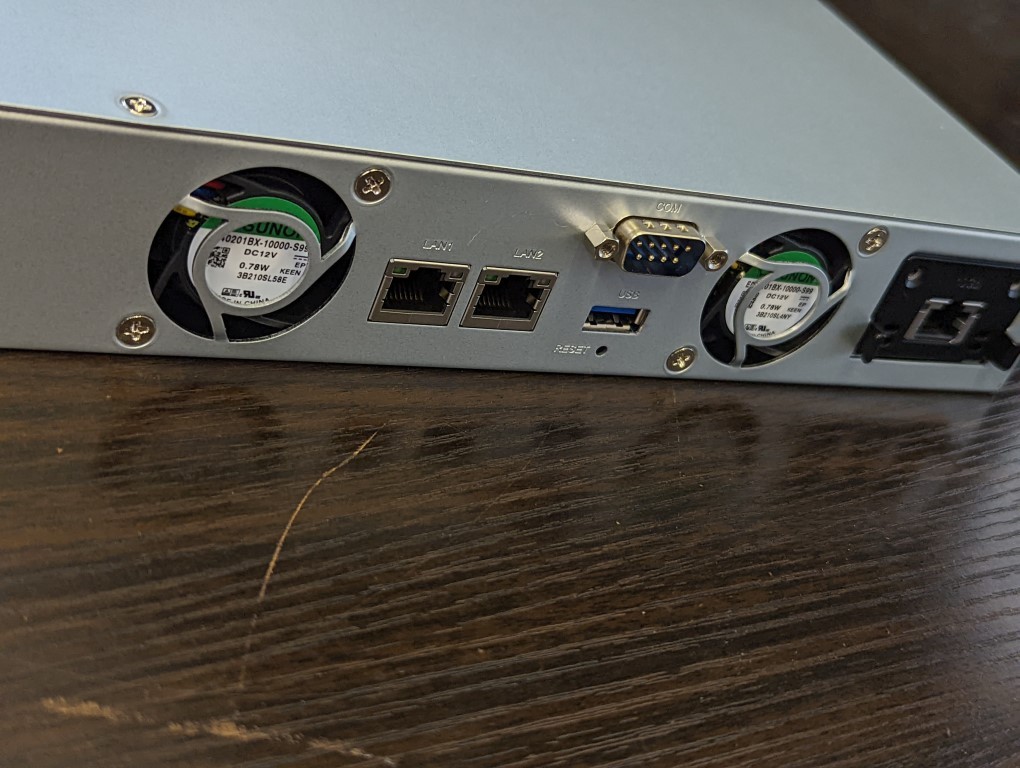
Now one of the latest additions that Synology have been making to its 2022 generation of NAS solutions is in the subject of 10GbE upgrades. Network upgrades in Synology NAS systems (including many desktop NAS systems) have always been on offer on many of the PLUS series devices, however in the case of a few (including the RS422+) the way this is made available has changed. The Synology RS422+ features a small, square upgrade card slot on the rear of the chassis that is specifically marked as the Network Expansion Port.
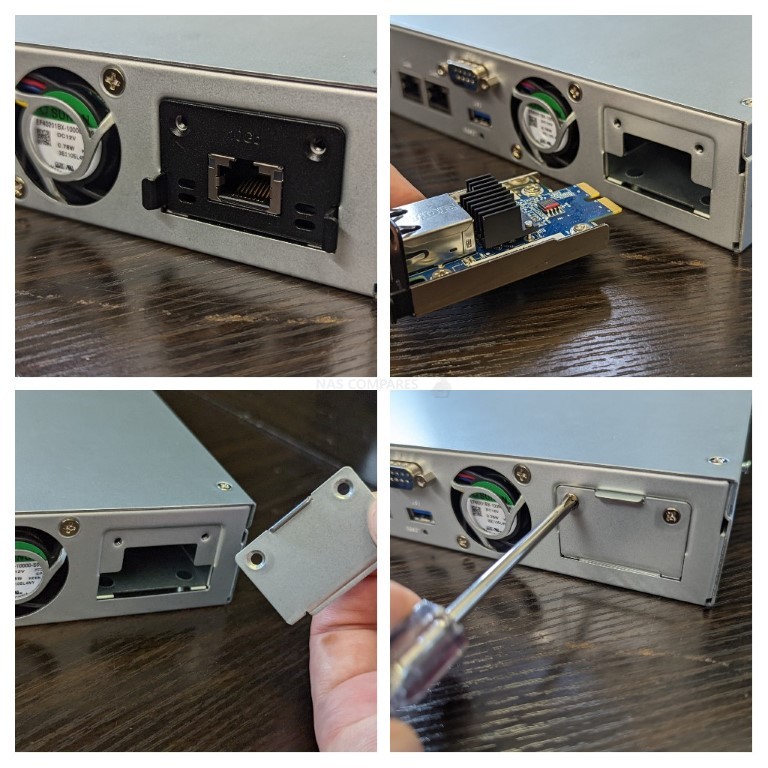
Although architecturally this is similar to a PCIe slot, there are a few very important differences. The first is that you can no longer use standard 10GbE upgrade cards that arrive in full/half-height PCIe here. In order to attached 10GbE to the RS422+, you will need to use the new E10G22-T1-mini adapter module. This is a new, quite proprietary upgrade unit that slots into this available network expansion slot of the RS422+ that, although much less invasive to install and easier to maintain, is a very brand specific piece of kit and not something that you can buy from a third-party vendor. Now, this isn’t a huge surprise. Synology has been increasingly focusing on first-party accessories and components for their hardware for a whilst now (HDDs, Memory, SSD Cache, etc) so another move into the one-ecosystem/all-in-one solution-provider area by the brand is not going to surprise too many. However, Synology already has a range of very, very good PCIe cards to upgrade towards 10GbE, 25GbE and even combo cards that are all very good. I think it would have assumed that a traditional PCIe slot on the RS422+ would not have been especially hard (looks at the other 1U rackmounts – even those with Atom processors in the past). Equally, as this new 10GbE adapter is very new, prices are quite irregular right now and in many places the new designed 10GbE adapter is more expensive than the current PCIe E1018-T1 card.
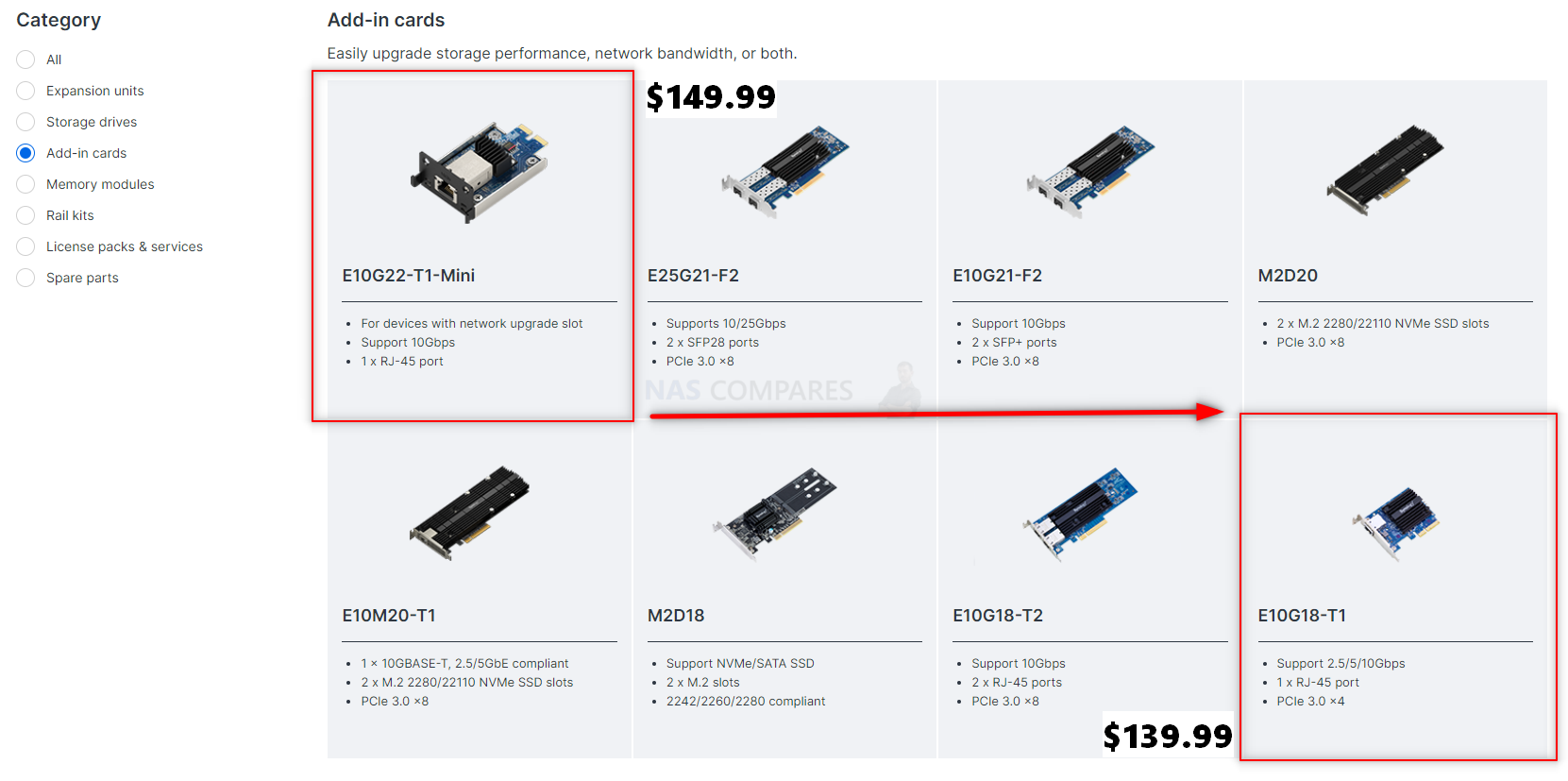
The new 10GbE adapter card is PCIe Gen 3 x2, whereas the older generation PCIe card is PCIe Gen 3 x4 which, although might sound like the older card is better, means very little as the card is still a 10Gb card and both of these PCIe speeds/gens will give way more bandwidth than these cards can possibly saturate. The slot inside the RS422+ is also a PCIe Gen 3 x2 slot too. Not to labour the point more, but where is the SFP+ option too? This card arriving for rackmount, at least in my eyes, would certainly see a decent % of users wanting this is fiber for those longer distances and larger scale building installations. Perhaps the E10G22-T1-Mini is the first step towards an E10G22-F1-mini or E10G23-F1-mini? We shall have to wait and see.
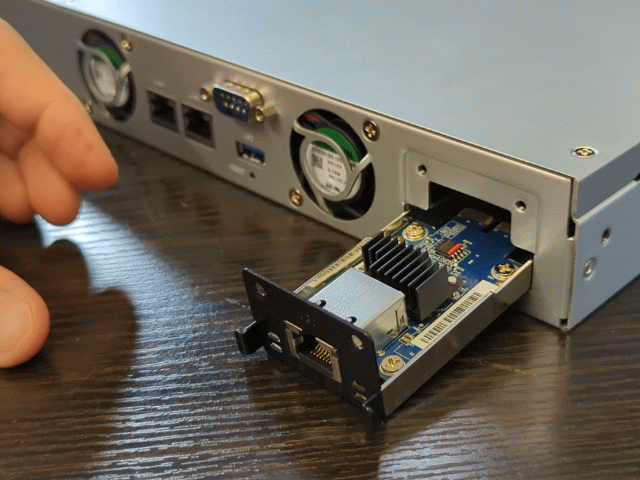
What about the default network bandwidth of the Synology RS422+ NAS? Well as you might have suspected, it is another release from the brand to feature 1GbE network ports. Now, one might argue that this is the CHOICE to add 10GbE via the previously mentioned slot if increased performance is needed. Additionally, some might argue that the current trend for 2.5GbE in NAS is not essential, given that 1GbE and 10GbE are the more widely adopted client hardware connections. Those are both good points with a degree of merit. However, two 1GbE network ports here (so 109MB/s, or around 220MB/s or so via link aggregation) are going to immediately be a bottleneck for those 4 drive bays (HDD or SSDs). Additionally, 2.5GbE is fast arriving at the same/similar cost to 1GbE on client hardware (switches, routers, adapters via USB costing as little as $20) and although 2.5GbE has lower integration now, who’s to say where it will be in a few years and for users who are investing in a NAS with future-proofing in mind, 2.5GbE would likely have been appreciated. Perhaps Synology can make a case of PCI lanes on the CPU being stretched thinner – but with a reduced network upgrade slot of PCIe 3×2 (previous devices have 3×4 or 3×8) and 2 LAN ports, not 4 as seen previously, this does seem like an odd move.
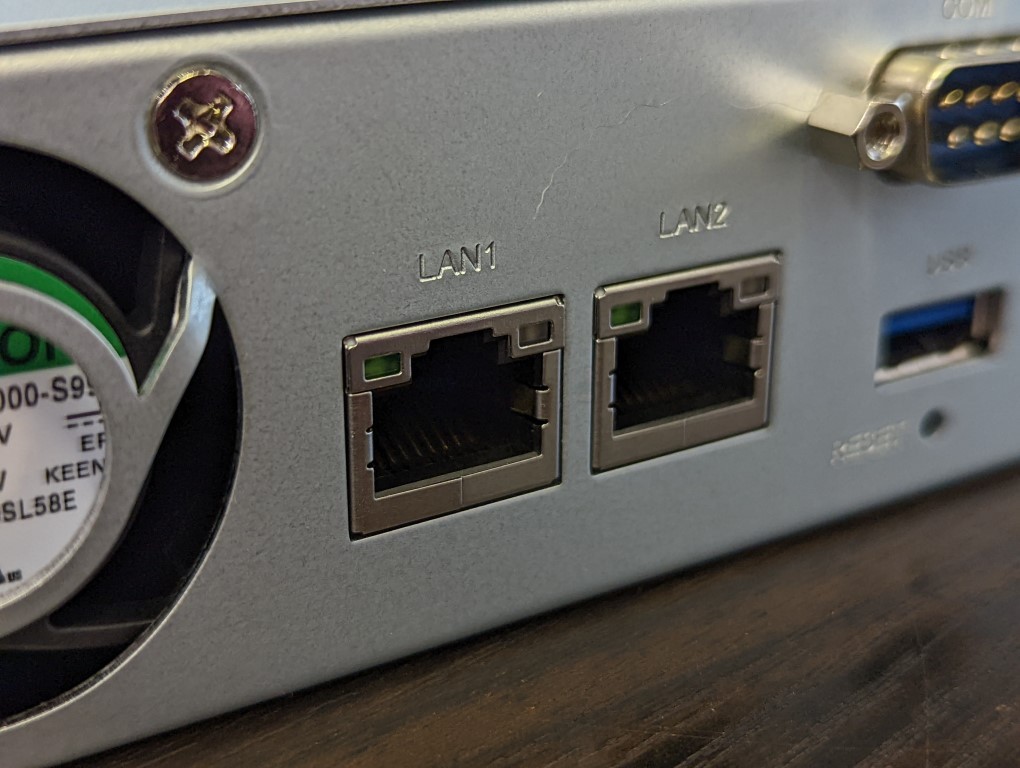
The last ports present here are a USB Port and a COMs port. The COMs port we can largely ignore (those that need it will already know about its use and connection to existing systems in-house), but the USB port here is another puzzler. For a start, there is only x1. Even if you only factor in that Synology provides these for UPS devices and external storage (many other compatible devices such as printers, scanners and network upgrade adapters have had support discontinued or unverified officially), that still means that there is only one port to do this. Given the lack of a redundant PSU, most businesses will use this for a modest UPS – a 24×7 connection, so USB storage is off the table. Another example of this system appearing a little streamlined in comparison to many other rackstations.
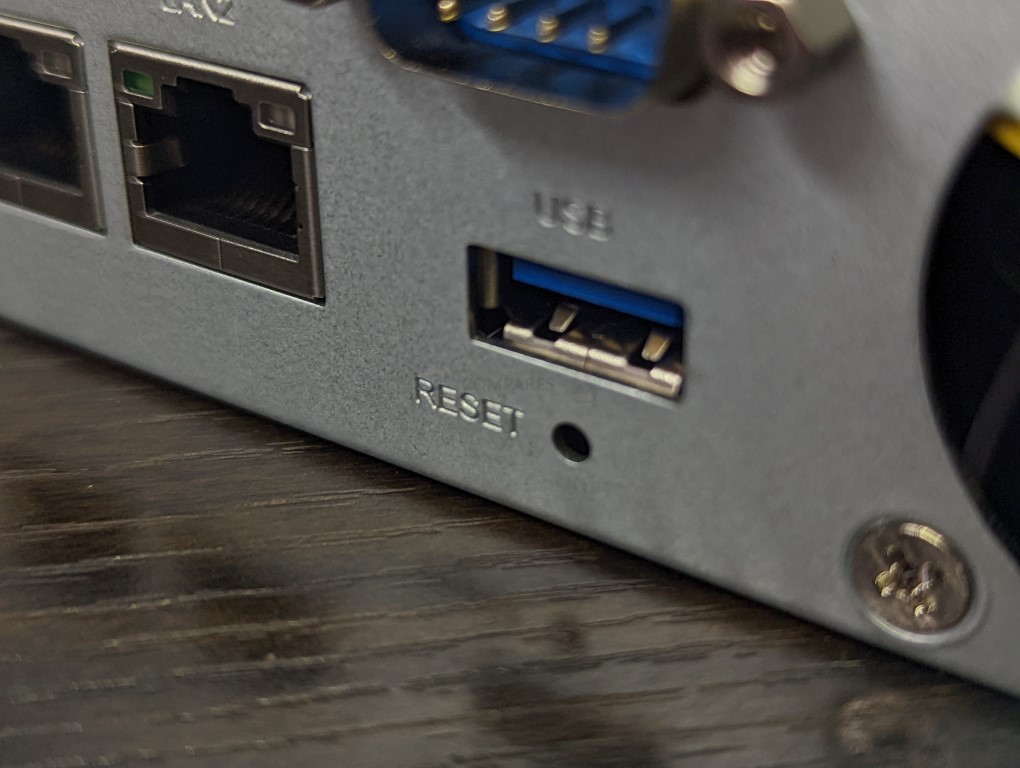
Then there is the subject of expandability – of which the RS422+ supports zero. Unlike the recently revealed RS822+RS822RP+, the RS422+ does not have an eSATA/External-SAS connection for an expansion bay. On day one, that’s ok. But years down the line, even the support of SHR is not going to be particularly useful in this 4-bay system when needing additional storage for existing volumes and shares. That’s a shame, as the 10GbE expandability would have paired well done the line with increased storage as your data grows.
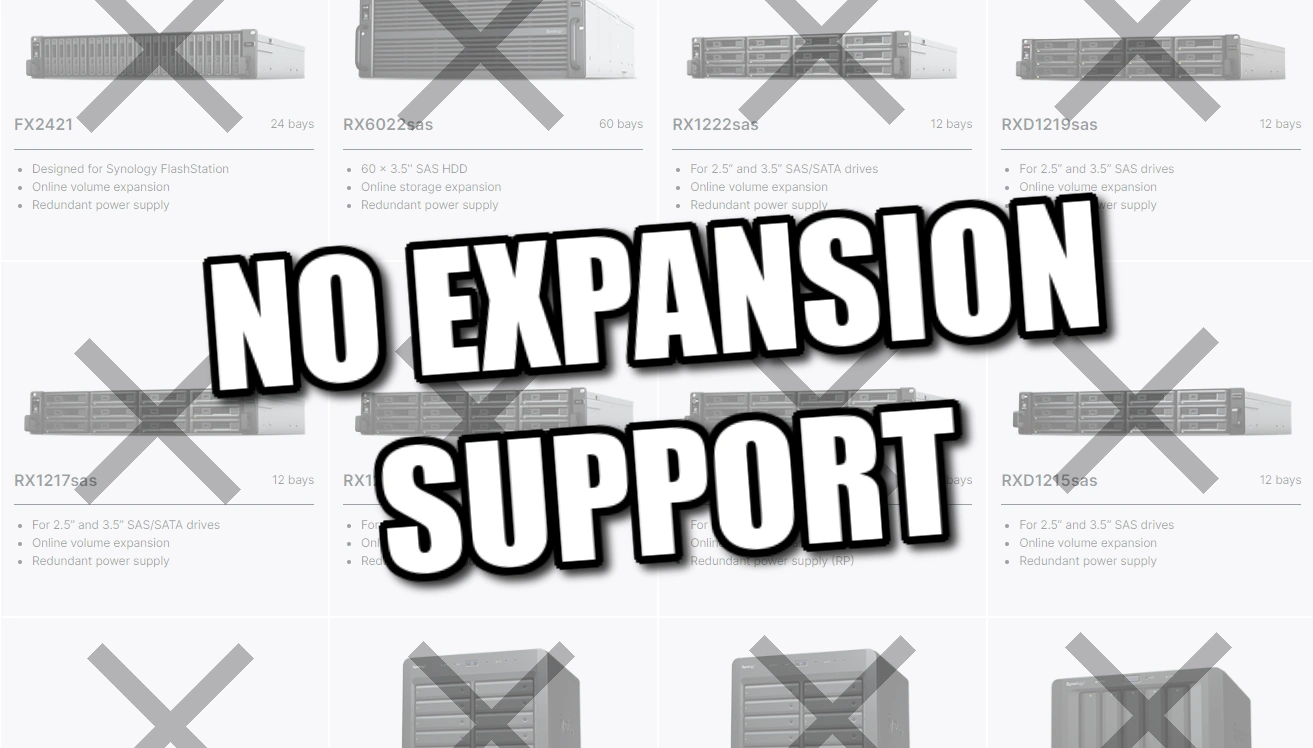
The ports and connections of the Synology RS422+ are ok. The inclusion of a 10GbE option is nice, but already something featured in 1U Plus series rackstations before – and in a less proprietary form. The 1GbE ports are a tad underwhelming, but there is always the case that users who do not think 1/2GbE is enough will immediately jump to 10GbE anyway. Let’s dig a little deeper and see what the inside of the Synology RS422+ has for us.

Synology RS422+ NAS Review – Internal Hardware
The chassis of the Synology RS422+ Rackstation NAS has an accessibility panel on the top of the chassis that allows access to the internals of the system. However, the RS422+ does not really have any internal upgrade options, so the main reason that you may need to access the system internals will be for cleaning/light maintenance. It is held in place by 5 screws and slides off very easily, exposing the internal board and the storage bays (which take up a good 60% of that space).
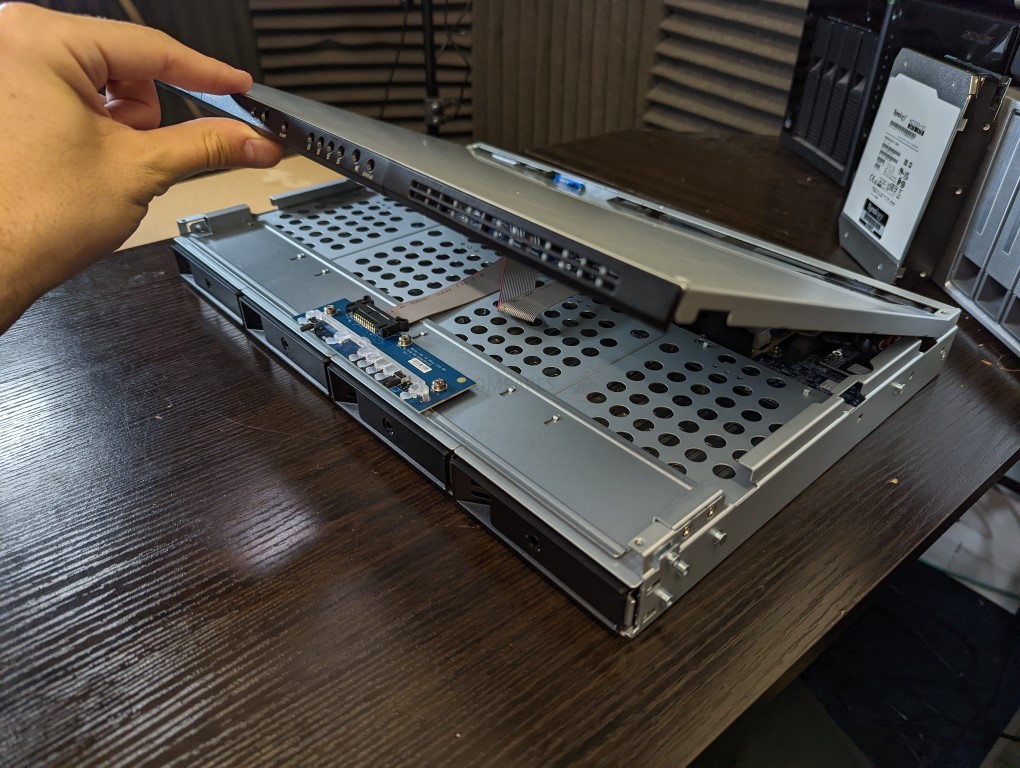
There is a tonne of space and ventilation throughout and the PSU is not a closed unit either, but a bare PSU to allow 1) a more compact and convenient arrangement internally and 2) further cooling/ventilation. The arrange meant of components across the main controller board is very clean and you can clearly see the key components have been sensibly spaced out too. The small flash module that contains the default DSM installation package is tucked in at the corner and the system arrived with DSM 7.0.1 by default. It is worth remembering that DSM, when installed, lives on the core storage drive media/RAID and this flash module is for first-time setup, as well as getting updated with the latest version of DSM (for future reinitialization) during setup.
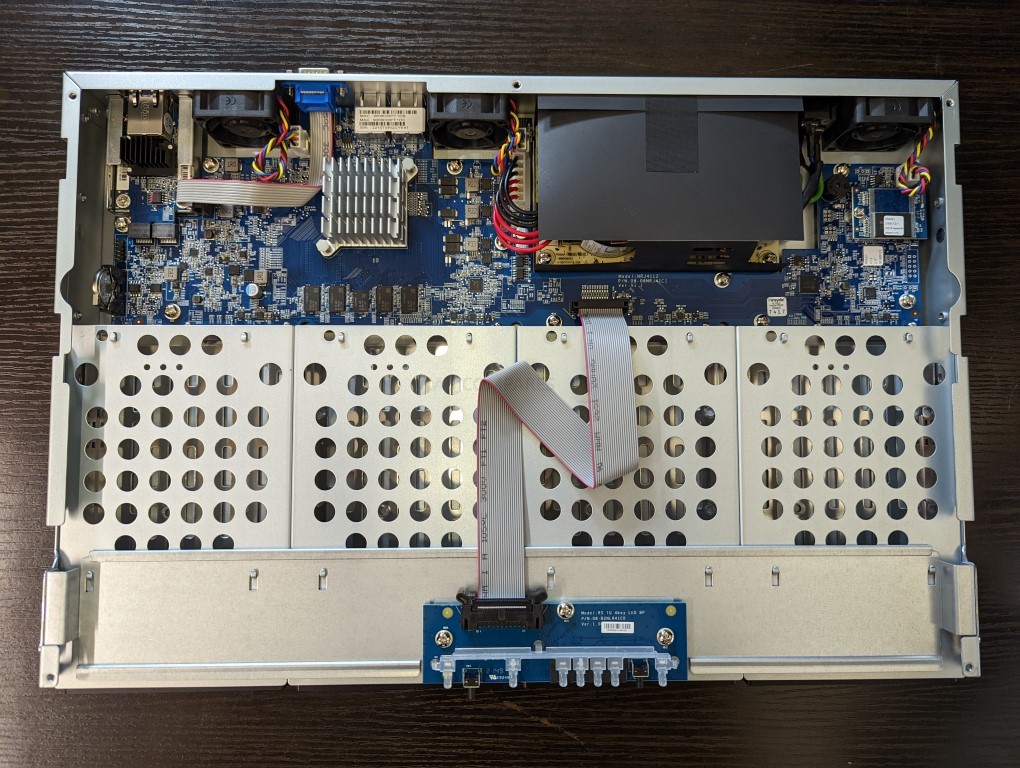
The 2GB of DDR4 memory that this NAS arrives with arrives soldered to the main controller board, as opposed to arriving in an accessible/changeable SODIMM upgrade slots. This is going to divide opinion a little and how this gets judged comes down a little to how this device is going to be marketed. As a value/cost-effective system, fixed memory is quite standard and allows easier and more affordable production, as well as allows the brand to flesh their portfolio out towards a buyers spending/budget-priorities alot better. If this is a prosumer and/or mainline SMB system – then having this memory locking in at 2GB is a little less positive. The memory comprises 4x DDR4 512GB modules and an additional module that is the ECC component of this memory – something many database and file management NAS buyers are going to appreciate!
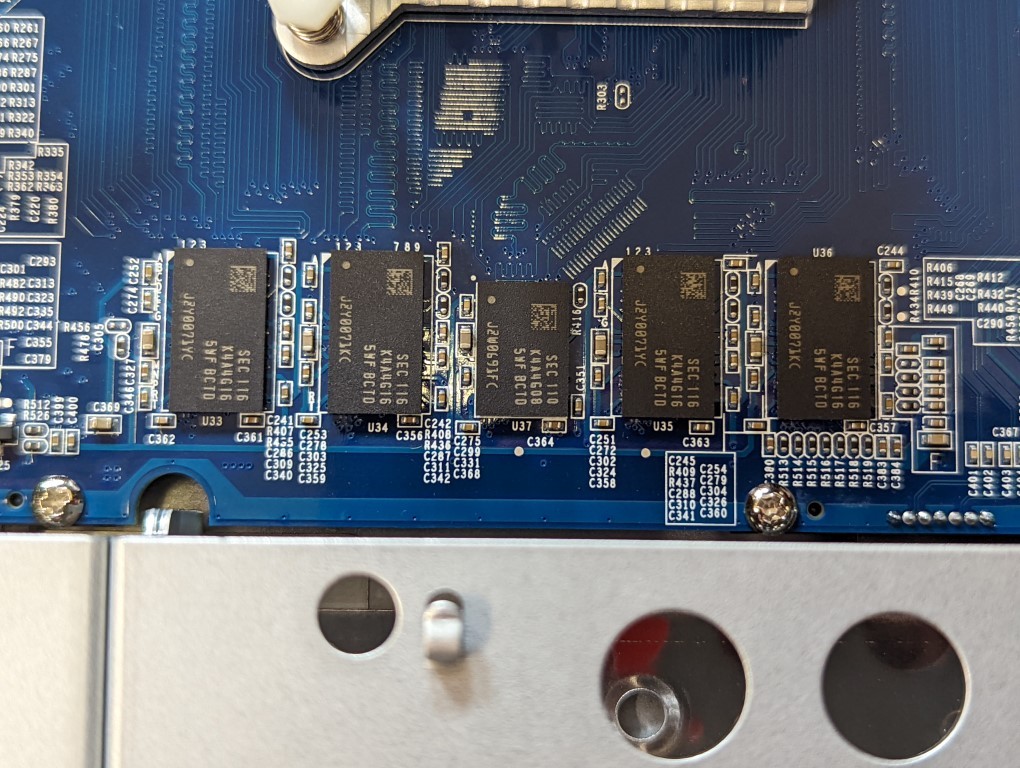
It’s definitely a bonus that the RS422+ NAS is yet another solution from Synology that features error-correcting code (ECC) memory, which is certainly a high-end business preference for many. This type of memory benefits from an additional module on board that checks data as it enters and exits the RAM and if inconsistencies or errors occur during the write, this memory recognizes this when comparing the format of the binary at the beginning and end of its pass through, restoring the data to its integrity before it is committed to the larger NAS system during a write operation. Those that utilize larger databases or simply huge amounts of data that are high in frequency but low in volume. Will certainly see the benefit in this rather than encountering corrupted data days, weeks, months or even years down the line. This is by far the smallest rackmount/rackstation NAS that Synology has released to feature this more enterprise-grade memory.
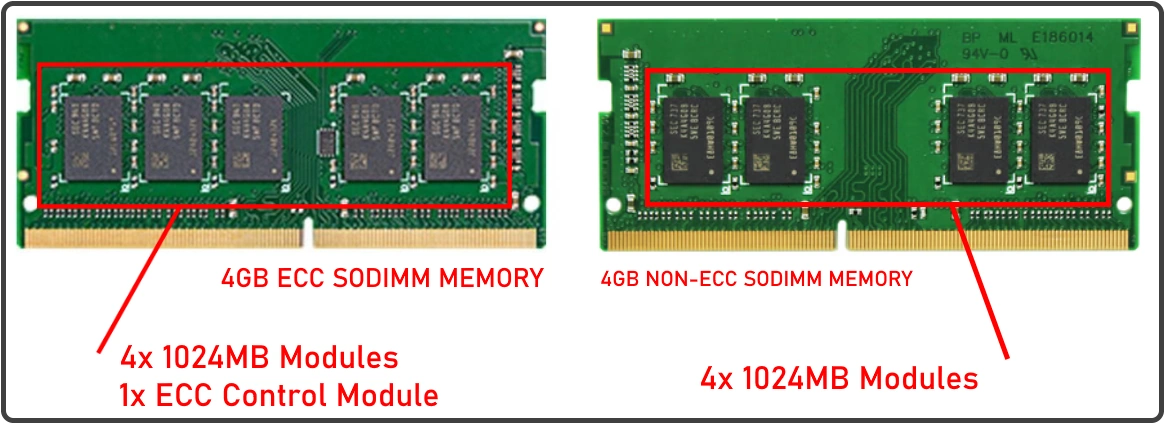
Now, let’s get it out the way immediately. For a four-bay NAS device running DSM7 and with an optional 10GbE connection – the Ryzen R1600 is a good CPU. Its two-core, four-thread architecture, though a little weaker than many would have hoped, has an excellent power vs efficiency level and when combined with the support of ECC memory enables the system to get more done reliably and also whilst utilizing less raw power. Other desktop and rackmount NAS from Synology that feature a similar quad-core Ryzen (the V1500) proved that this processor is more than up to the task of managing multiple RAID pools and volumes whilst in 24/7 server use. Equally, no doubt Synology have benefited from lessons learned in the previous embedded Ryzen NAS developments that have resulted in this new R1600-equipped system benefiting in how well it runs DSM7 applications. Although industry measurements are a little few and far between on this relatively new processor, the hardware architecture behind it stands out very well.

The issue for many thought, as mentioned earlier in the review and in my DS1522+ NAS review, is going to be that this is NOT an embedded graphics processor and many users look at this scale of solution as a mixed-use device for home and business, or just for purely enjoying multimedia, are going to be a bit underwhelmed as that is something that this processor is less suited for. The hardware architecture we have here is going to result in very high CPU utilization for even mid to low-end multimedia handling and heavier tasks such as 4K multimedia and transcoding while streaming, are going to push this process to the 100% utilization mark very quickly. Many are concerned that Synology may be in the process of reshaping the lower tiers of their portfolio to solely utilize these Ryzen processors, something I assume and indeed hope not to be the case. Additionally, it is worth highlighting that this particular family of Ryzen CPUs (The R1000 series) does feature AMD Vega embedded graphics options, so it is an odd choice by the brand to stick with this product family but opt away from more graphically proficient processors that are in the line-up.
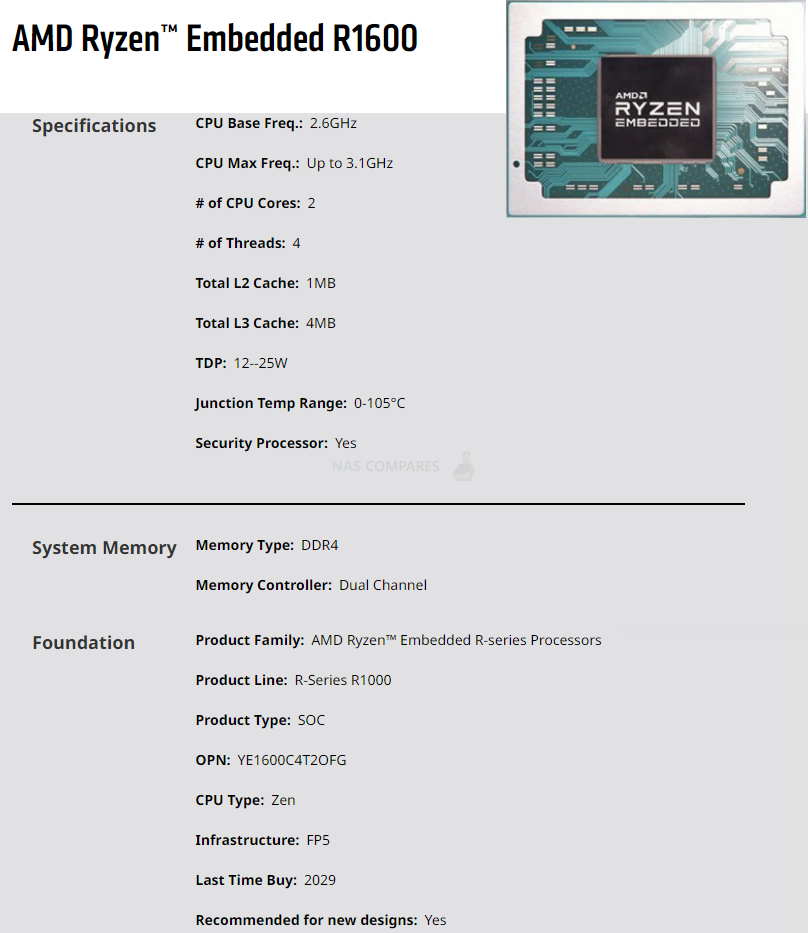
Now, it is ALSO worth noting that Synology has very, VERY rarely featured an embedded graphics chip in their rackstation series and in this tier of their portfolio (i.e between ARM 32/64bit processors and expandable Atom/v1500B equipped rackmounts) the R1600 processor IS a step up! The Sequential performance with four Synology HDDs in a RAID setup via the 10GbE adapter was rated by Synology at 601MB/s Read over 516MB/s Write – which does sound low for a 10GbE connection, but you have to factor in that these are HDDs and a pure SSD setup in the write RAID could likely fully saturate the 1,000MBs connection. We were able to hit this with Seagate Ironwolf SSDs, but did not have Synology SAT5200/SAT5210’s on hand to test with the first party media.

The hardware inside the Synology RS422+ is not certainly very deliberately designed to provide a solid base of resources to run DSM/3rd party services whilst still maintaining a god price point, but also resulting in a much lower glass ceiling in terms of future-proofing and scalability of the system. Having a 10GbE upgrade is always welcome, especially at this price/storage tier, but the lack of an expansion option, lack of option to upgrade that memory above the default 2GB and lack of M.2 NVMe SSD slots to take advantage of caching (despite the £650/750 DS1522+ NAS featuring them + 8/32GB Memory, 1 more bay + 1 more USB, but the same R1600 CPU) is going to quite a hurdle for those who want to provision for the future of their storage system. Let’s discuss the Software that is included with the RS422+ Rackstation NAS, as DSM 7 is still very much the jewel in the crown of Synology’s NAS solutions in 2022, 2023 and beyond.
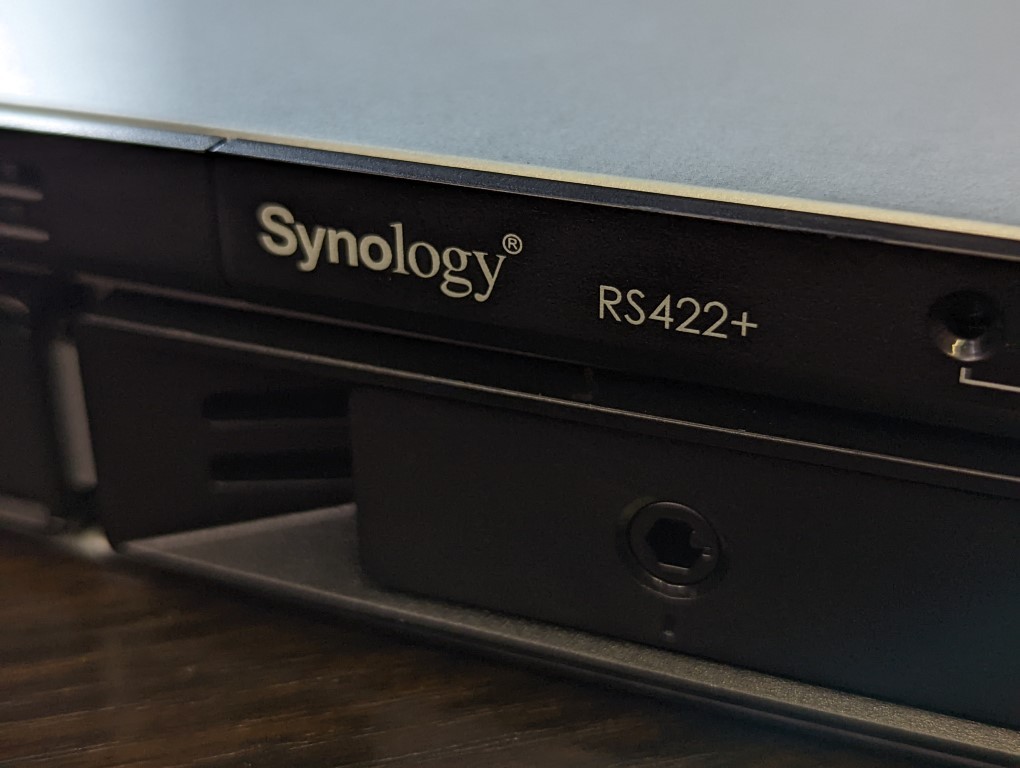
Synology RS422+ NAS Review – Software and Services
Now, to cover the WHOLE Synology software and services that are included with the RS422+ NAS would result in a review that is twice as long as this review so far! Synology’s Diskstation Manager software that comes with this device (either DSM 7 or DSM 6.2 depending on your preference) provides a massive arrangement of services, applications (first and third party supported) and a huge number of client applications for desktop, mobile, windows, mac and Linux (as well as a bunch of other more home-based tools). These allow management and access to the data on the RS422+ in very tailored ways, as well as the web browser-based access that has the appearance, intuitive design and responsiveness of a local operating system. The DSM interface can be accessed by hundreds of users at the same time (with each user having tailored access, rights and privileges). DSM is available with ALL Synology NAS and the depth and abilities of DSM on any NAS are dependent on the hardware architecture of the NAS itself. In the case of the Synology RS422+, it supports practically EVERYTHING (with the exception of SHR, as previously mentioned). If you want to learn about the latest version of DSM 7 and the software and services that are included with the RS422+ NAS, watch my FULL review below (alternatively, you can read the DSM 7 Full Review HERE):
As mentioned, the RS422+ supports pretty much the entirety of the DSM 7 and DSM 6.2 applications and services. If you are an existing user of SaaS and PaaS (Software as a service and Platform as a service) from the likes of Google Workspace and Office 365, knowing that you can synchronize these systems or choose to export away from them onto the Synology services is going to be very appealing. Key business applications that are included with your NAS are:
Synology Office – Create documents, spreadsheets, and slides in a multi-user environment. Real-time synchronization and saving make collaboration a breeze.
Synology Chat – Aimed at businesses, Synology Chat is an IM service that transforms the way users collaborate and communicate.
Synology Drive – Host your own private cloud behind the safety of your NAS with 100% data ownership and no subscription fees.
Synology Moments – Manage your photos and videos with deep-learning algorithms that automatically group photos with similar faces, subjects, and places.
Synology Calendar – Stay on track, share calendars, and schedule meetings, while ensuring sensitive information remains safely stored on company premises.
Synology Active Backup for Business (ABB) – Consolidate backup tasks for virtualized environments, physical servers, and personal computers, and rapidly restore files, entire machines, or VMs – completely license free.
Synology Hyper Backup – backup you NAS safely and efficiently to multiple destinations with deduplication, integrity checks, compression, and versioning.
Synology Surveillance Station – Safeguard your business, home, and other valuable assets with reliable video surveillance tools.
Synology Virtual Machine Manager (VMM) – An intuitive hypervisor that supports Windows, Linux, and Virtual DSM virtual machines. Its powerful disaster recovery tools help users achieve maximum service uptime.
Synology High Availability – Synology High Availability (SHA) combines two Synology NAS servers into one active-passive high-availability cluster, alleviating service disruptions while mirroring data.
Synology Central Management System (CMS) – Synology CMS allows you to manage multiple Synology NAS servers quickly and conveniently from a single location.
Synology Video Station – Manage all your movies, TV shows, and home videos. Stream them to multiple devices or share them with friends and family.
Synology Photo Station – Built to help photographers manage their photos and share them with clients for feedback or business development.
Synology Audio Station – Manage your music collection, create personal playlists, stream them to your own devices, or share with family or friends.
Synology File Station – Manage your Synology NAS files remotely through web browsers or mobile devices.
You cannot really fault the software and services that are included with the Synology RS422+ NAS, as you are going to get the very best experience available on the platform, thanks to the hardware and architecture of this NAS. DSM 7 is an every evolving platform, so if you are reading this now at the time of publishing or years later, there is always going to be something in DSM for everyone.
Synology RS422+ NAS Review – Conclusion & Verdict
What Synology has produced in the RS422+ Rackstation NAS is an intriguing middle ground between their more cost-effective ARM-based rackmount solutions and their more expensive scalable and upgradable servers. On the face of it, you are getting a tremendously compact but capable 1U 4-Bay rackmount server that, as soon as you factor in the included DSM software and services, is very good value for businesses that want to move their data out of 3rd party cloud and into something they have full control over. Additionally, that CPU (though a fraction divisive when compared previously vs Intel chips in the desktop DS1522+) makes more sense here in this more affordable Rackstation solution. The lack of NVMe M.2 SSD slots, fixed 2GB memory and lack off rails I am less keen on here (and I am still a little on the fence about the way they have pursued 10GbE upgrades in this system) but you are still getting a very well built and small scale NAS solution here and Synology have found a good price point here for this complete solution. Additionally, the fact that Synology has not been so restrictive on HDD use in this system than in more enterprise solutions in 2022 is welcoming too, though they are still taking an odd stance on some drives nonetheless. Ultimately, I can recommend the Synology RS422+ Rackstation NAS to smaller business users, though looking for a compact and very easy-to-deploy NAS solution for surveillance, central business storage, additional backup layers and for DSM as a whole. Though multimedia users might want to give it a miss.
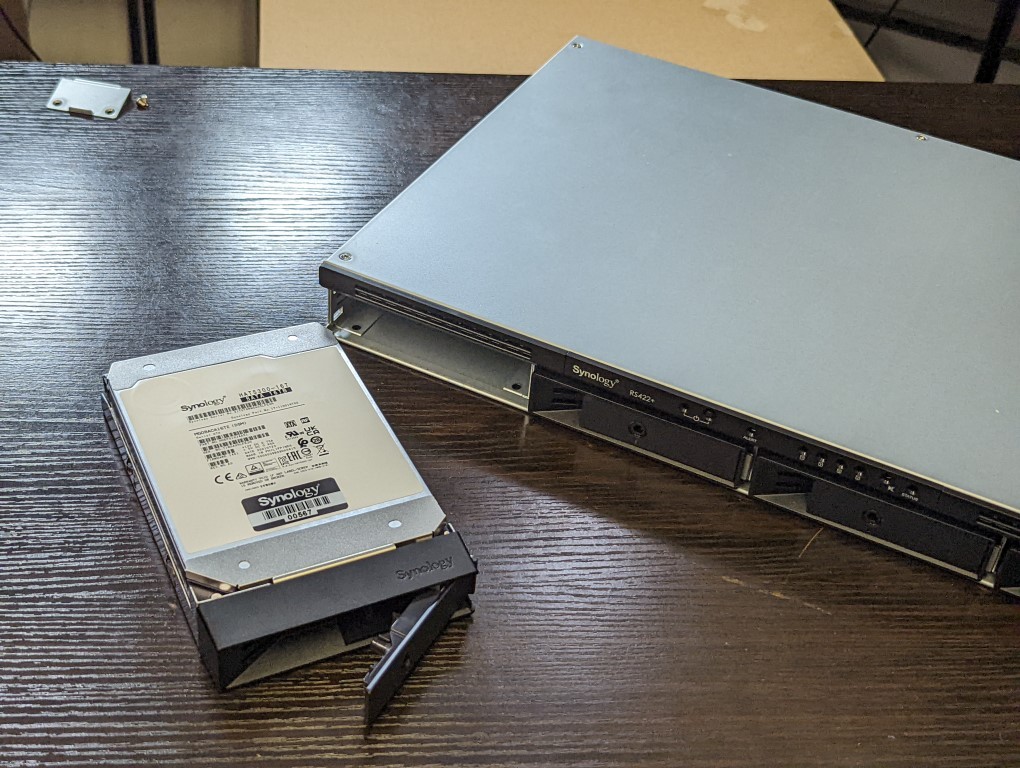 |
|
| Synology RS422+ PROS | Synology RS422+ CONS |
|
|
🔒 Join Inner Circle
Get an alert every time something gets added to this specific article!
This description contains links to Amazon. These links will take you to some of the products mentioned in today's content. As an Amazon Associate, I earn from qualifying purchases. Visit the NASCompares Deal Finder to find the best place to buy this device in your region, based on Service, Support and Reputation - Just Search for your NAS Drive in the Box Below
Need Advice on Data Storage from an Expert?
Finally, for free advice about your setup, just leave a message in the comments below here at NASCompares.com and we will get back to you. Need Help?
Where possible (and where appropriate) please provide as much information about your requirements, as then I can arrange the best answer and solution to your needs. Do not worry about your e-mail address being required, it will NOT be used in a mailing list and will NOT be used in any way other than to respond to your enquiry.
Need Help?
Where possible (and where appropriate) please provide as much information about your requirements, as then I can arrange the best answer and solution to your needs. Do not worry about your e-mail address being required, it will NOT be used in a mailing list and will NOT be used in any way other than to respond to your enquiry.

|
 |
The Best Bits (and Worst Bits) of NAS of 2025!
Minisforum MS-02 Ultra Review
Minisforum N5 NAS, 6 Months Later - Better, Worse, the Same?
Beelink ME Pro NAS Revealed
Best SOLID STORAGE NAS of 2025
Should You Worry About the NanoKVM Hidden Microphone?
Access content via Patreon or KO-FI
Discover more from NAS Compares
Subscribe to get the latest posts sent to your email.


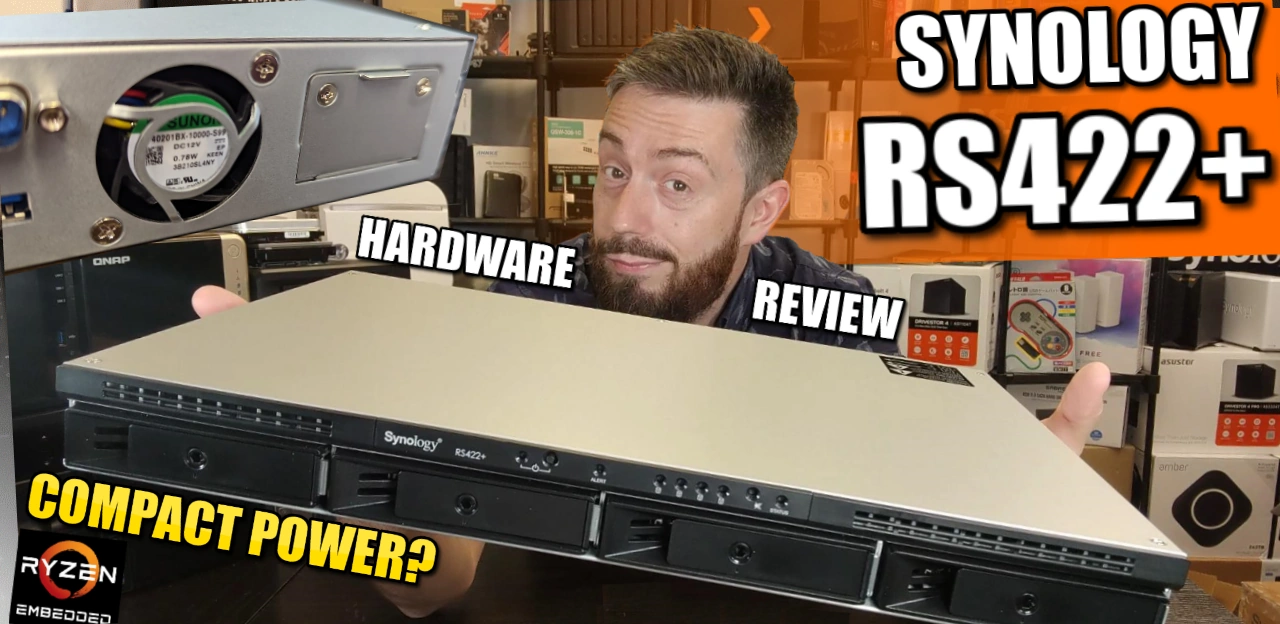




How noisy is this thing ??
REPLY ON YOUTUBE
is this a better option than a DS 517 extension for my other rsynology as I have just bought the expansion and its so slow. can I see do synologys in the same system?
REPLY ON YOUTUBE
So for your question about rails. There’s no need to have rails on something like this. There’s no access to the system from the top. You will mount it into the rack via the ears. if you have to pull it out, you just pull it out. There’s no need for rails on something that doesn’t have top access. You also mentioned about how light it is, rails make it easy to handle heavy servers, not a 10 lb. NAS.
REPLY ON YOUTUBE
Does this device allow third party RAM upgrades?
REPLY ON YOUTUBE
Such a great channel So helpful Thanks.
I am dipping my toe in the NAS market, and am after one for my small home business.
I’d quite like a rack mounted one – but that’s not essential.
So question is – is there a performance / price trade off with the RS422+ as it’s rack mounted? Would I get a better desktop Synology NAS for roughly the same amount of dough? (Money / knicker / wonga)
Not bothered about Multimedia, but will do VMs, docker and of course file syncing / backup etc
Any advice much appreciated.
Thanks again for all
Andrew
REPLY ON YOUTUBE
I copied a large amount of photos and videos in my new RS422+. Thumbnail generation process is very slow and I kept receiving overheating alarms as the CPU temperature reached 95°C. So I decided to replace the thermal paste hoping it would help. It does make a difference now the temperature sits around 85°C, while generating thumbnails.
REPLY ON YOUTUBE
*Update, Synology DSM has been updated to DSM 7.1. So, check out my MASSIVE Synology DSM 7.1 Software Review HERE – https://youtu.be/SqFa0WyxGJc *
REPLY ON YOUTUBE
This device’s 1GbE LAN ports have a maximum transmission unit (MTU) size of 1,500 bytes. —- no 9k Jumbo frames support,, ?
REPLY ON YOUTUBE
Can you install VMM on RS422+? On Synology web is this option missing… But for my user case it would be perfect solution instead of buying quite expensive 822+/1221+
REPLY ON YOUTUBE
Hi I got the Synology RS411 and I don’t have any HDD for now and I can’t get connection. Do I need to have a HDD at least? How do I install the SO? What I must do? ahah thaanks
REPLY ON YOUTUBE
Don’t look now mate, but the seagull what done it is sitting right there!!!
REPLY ON YOUTUBE
should have cost half, rails included, 10Gbe included,
at this price point Synology shot themselves in the knee,
I understand homelabs and smbs may want networked drive bays without anything extra, which arguably this unit aims for, but once you add proper server next to it, this should be priced like 4-bay USB-C/Thunderbolt enclosure at best….
REPLY ON YOUTUBE
I‘m in the market for that form factor, but this is just too limited. Waiting on reviews of the QNAP TS464-eU.
REPLY ON YOUTUBE
Hard disk compatibility is short, just Synology and some IronWolf/seagate and Toshiba,, so if I going to use my old WD i will get the warning about the disk ?..
REPLY ON YOUTUBE
There’s a lot of variability in rack depth so kind of understand them not supplying massive 600mm sliding rails to everyone but some extending side supporting shelves would be good.
Would the 16TB limit be related to the current (Toshiba MG) Synology branded drives maximum size?
Would be nice to have more USB, 2.5g, and ESATA to handle a port multiplier and storage expansion.
Not sure 10g really needed with hard drive storage.
REPLY ON YOUTUBE
Why aren’t the Ethernet ports in the front? In a rack,… patch panels in the front…. so I have to slide it out and route behind? C’mon.
REPLY ON YOUTUBE
Thank you
Helped me a lot and saved some Time
I’m looking for a replacement for my DS 716
The short rack is interesting for me but only 2 GB is not enough
Still hoping for a 722+
REPLY ON YOUTUBE
Who is even the target audience of this? It’s a rack mount, which indicates enterprise or at least SOHO/SMB. But then you look at the CPU, which is woefully underpowered as well as the laughable 2 GB RAM NON-upgradable, which wouldn’t even satisfy anything but the very basic home users. Add to that the HDD compatibility list which do list NAS drives, but no pro or enterprise ones barring Synology branded models which they will ofc always try to push. And then ofc the 1G NICs. I mean does this even know what it wants to be?
No Rob, you’re not being negative. You’re rightly questioning Synology for another pointless product, in your own very polite way even though they don’t deserve it. Good on you ????
REPLY ON YOUTUBE
This is not a well-equipped storage solution. This is a minimal black box (siler actually) that needs media to do anything. This lacks CPU power, memory, only 8 PCI lanes, no GPU, no caching benefit, and still $699 bucks.
REPLY ON YOUTUBE
Are there rumors on a 922+ still? Is this still a possibility? If so, why are they waiting to release it?
REPLY ON YOUTUBE
I love seagulls and i hate excessive packaging ????
REPLY ON YOUTUBE
Sliding rails would be useful if there was a top cover you could take off, like on servers. The non-sliding ones are useful if you need to distribute a heavier load across four posts of the rack. I don’t see a dire need for either in this case.
REPLY ON YOUTUBE
In terms of the mute, the idea of it is not for you to walk over into the datacenter to mute the beeping. It’s there to provide the ability to silence the alarm to those working near the beeping device and to acknowledge the fault. This is especially useful if you’re addressing something unrelated/more pressing at the moment and will only look at the issue with the NAS at a later time.
REPLY ON YOUTUBE
28:40 can you use a usb hub with it?
REPLY ON YOUTUBE
The mute button make sense, if u have a more stations (20) in a rack and all have a problem, you need to work in this room. You have newer 20 desktop disk stations in one room, or?
REPLY ON YOUTUBE
My Synology review: Opens box, throws in trash. Review done.
REPLY ON YOUTUBE
Did you work in the Waitrose on Western Road in Brighton by any chance?
REPLY ON YOUTUBE
your The NAS Master good job
REPLY ON YOUTUBE
I wish rails were included for the short-depth NASes but even Synology do not make rails for their short-depth series. You can of course fit their full-depth rails but for that to work you have to have a deeper rack. Where these NASes are most useful is in the SMB and Prosumer space where short depth racks or even comms cabinets are common; so long rails are impossible to fit. There are lots of racks out there where hanging from the front is either awkward or just beyond the strength of the front uprights – bending and sagging is not a good look.
Anyway, poor connectivity, poor CPU, no graphics, no upgradable RAM does indeed = J-series but this is badged and priced as a Plus Series. It is a bad deal.
REPLY ON YOUTUBE
I don’t use rails and I don’t see why you would need them for such a shallow chassis. I’m glad they don’t include them so I don’t feel like overpaying for stuff I don’t need. I do like the new 10GbE card, much easier to install. But proprietary usually ends up being expensive. The onboard 1GbE should’ve been 2x 2.5GbE though. Now it’s almost mandatory to buy the networkcard.
REPLY ON YOUTUBE
I cannot beleive that there is NO WAY to sync any folder and file type from android device to synology nas… that drives me nuts… it’s either super complicated third party app to configure or the only syncing possible is with ds file that does ONLY pictures or synology photo crap app… I just want to sync ANY folder and their files in it (like download, ringtones and so on)… why the hell can’t synology do such thing ??? ds cloud does NOT permit to sync android folder to nas, it only sync the cloud that is on the nas to the android device, I want the other way around, there is no way to sync android ANY type of android files to nas.. urgh…
REPLY ON YOUTUBE
My synology is messing up my local network and I can’t figure out why. Internet drops for a few seconds every few min on all connected network devices. If I disconnect the NAS from the network, it seems to work just fine.
REPLY ON YOUTUBE
Login Speed – seemed easier with entering user name and password on the same dialogue to only hit enter once, especially when credentials are stored in the browser. Perhaps they changed it for increased security, prefer the old way.
REPLY ON YOUTUBE
8:40 – I wish we could find the person responsible for using a Funnel for the filter icon and make them walk the plank. Funnels are not filters.
But its too late now. The damage is done. People associate the funnel image with the filter action in software just like they associate the piece of paper with a folded corner for “new file”.
REPLY ON YOUTUBE
The missing “For you” from moments sorely missed – it was a great AI system for finding potential duplicate (or near duplicate) photos that just doesn’t work as well as the storage manager reports that only really find exact duplicate pictures.
REPLY ON YOUTUBE
1.Log center cant be modified or set to exclude users or certain things you dont want logged.
2.It is not compatible with DScloud anymore so you cant sync to mobile like you can do on DSM6 with the DSCloud app from Synology but you can use the Synology Package Center to download Resilio Sync or Good Sync but you have to pay a monthly/yearly fee for every user.
Unlike Qnap when you buy your hardware, you arent forced to pay for syncing from and to your own hardware.
With that said there is still a solution using Webdav to-way Nas-pc with Raidrive but you have to pay for software for Pro features.
Mobile sync: Use Foldersync to-way Mobile-Nas, but you have to pay for software for Pro features.
So far as i am aware of limitations using Synology DSM7 when it comes to syncing —> If you want Pro features or you want to use your Nas without reaching out to third-part software without paying extra fees it is recommended to switch to other Nas brands for me i feel Qnap has been working using 30 users for Laptop/Pc/Mac/Android/Iphone all Apps/Software working perfect Pro features without paying extra fee´s or forced to use third-part tools total control for Log center, File-Folder, Photo, Video, Virtualization, Web-sites and so much more.
Other annoying difference i had with Synology i had was this—> i had to make a ticket to find out i cant use Synology Mobile App DS Cloud or that one cant choose what Synology Package-Log Center loggs, it wont let you choose to include, exclude or to delete certain logg if you press Clear button on the loggs that are in “Files downloaded” it deletes all, if you clear “user logins” it deletes all that and you cant revert the deletion.
REPLY ON YOUTUBE
Totally agree with your view on Photo Station. I’m glad you covered this as your feedback might get recognised. I don’t want to upgrade until Photos is comparable to what Photo Station had/has to offer.
REPLY ON YOUTUBE
almost perfection?
Audio Station is totally broken, playback is being cut off,
Media indexing fails to scan more than 50% files,
translations in DSM are not complete, some even have nonsense,
I have no idea what Synology have been doing all the time releasing such buggy software
REPLY ON YOUTUBE
918+ here with upgraded 16gb ram. Am I going to have issue if I upgrade to 7?
REPLY ON YOUTUBE
How do I change dsm7 login page to have username and password on same page?
REPLY ON YOUTUBE
Useful but a bit of a ramble with Robby. My time notes:
https://youtu.be/xZrjPF4nmRc?t=674
11:14 User Interface
12:00 Help Center
12:35 Control Panel
14:03 Security
15:27 Collaboration Suite
15:45 Synology Drive
17:18 Multimedia Apps
18:47 Plex and 3rd party app issues
19:47 DSM 7 background package integration improvements
20:25 HyperBackup, USB copy
21:24 Cloud Synchronization
22:27 Business Applications
23:30 Storage Manager
25:15 Fast Raid Repair
26:35 RAID 6 speedup
27:19 Bench testing, storage performance, UI improvements
29:00 Surveillance Station
30:04 Virtual Machine Manager
32:40 USB changes on DSM7
34:08 Security and UI
34:40 Resource Monitor and UI
35:00 Storage Analyzer
36:55 Recommendations
REPLY ON YOUTUBE
I’ve installed it as a VM on my DS1821+ and I’m completely disappointed with the new photos app. Maybe I’m old fashioned idk but the way timeline view is implemented it doesn’t allow you to look at a timeline on an album level anymore like you could do in photostation. You have to choose between album view or timeline view. I like to look at my photos different ways and this makes the app kind of unusable for me. Additionally I would like them to shows tags on the timeline view when you’re inside an album that has multiple albums underneath it but no photos in it directly. I’ve reached out to them but very little hope of it getting done in my opinion. I’m not upgrading until photos is useable as photostation is no longer supported on dsm7. Additionally I had a lot of indexing / conversion issues on my VM with my photos directory. Not sure if that’s just a VM issue or not
REPLY ON YOUTUBE
you talk way too much unnecessarily !!
REPLY ON YOUTUBE
The audio is of sync with the video
REPLY ON YOUTUBE
Since when Synology uses china domains ? Isn’t it Taiwanese company ?
REPLY ON YOUTUBE
How to downgrade back to 6.2?
REPLY ON YOUTUBE
Hi. Is it safe and or good for my Synology 920+ to be shut down during the night and sometimes for 30 days at a time while away? Many thanks for your great videos.
REPLY ON YOUTUBE
I upgraded both my DS 218J and my brand new DS920+ to DSM 7.0 and liking it a lot! No real problems. Moments with my Photos lost its tags during the transition to Synology Photos. I have to redo them but that’s ok. Everything else is great. I agree with this review.
REPLY ON YOUTUBE
so is there any reason for me to wait for the DSM update to come through automatically on my DS1520+ or should I just manually update now? Is it likely that more changes will be made to it before the automatic update comes through?
REPLY ON YOUTUBE
Boomer taskbar, jam packed .. just needs a few AoL or Geocities taskbars floating on the desktop to finish the effect.
REPLY ON YOUTUBE
No Java= no jdownloader????????
REPLY ON YOUTUBE
Does DSM 7 introduce any issues with access via the NFS protocol? I use my DS420j strictly as a file server in a Linux environment and do not really care about photo station, music station, etc. Quick, reliable access via NFS is my main concern. Thank you for your fine videos.
REPLY ON YOUTUBE
Photos all seemed to work once I requested a re-indexing. However, photo sharing is completely broken. Even if you request that anyone can view with a URL, Synology NAS still requests a username and password. Sigh…………………
REPLY ON YOUTUBE
I notice the absence of Amazon S3 on the cloud service for HyperBackup… Is it still possible to backup to Amazon S3 Glacier storage in DSM7? Or they removed it not to compete with their own C2 solution?
REPLY ON YOUTUBE
Thanks for your valuable videos. I missed the loss of DS Cloud, so syncing became a problem. I started using Syncthing after upgrading to DSM7. I also have a problem with Synology Drive from my laptop on a company network, while using Express VPN. It keeps trying to connect to the server. When I switch off the VPN it works fine. Maybe I will switch to Syncthing on this Windows machine as well. For me this is a key function for a NAS so I didn’t expect it to work less good. But all and all it’s a big improvement.
REPLY ON YOUTUBE
For anyone has done the upgrade, how long did it take please ?
REPLY ON YOUTUBE
Great video, thank you!
REPLY ON YOUTUBE
No mention of the issues with third party packages that worked fine in 6.2.4 but no longer work in DSM 7, it might be almost perfect IF you only use Synology apps.
REPLY ON YOUTUBE
Not upgrading until they add support for android folder backup/syncing!
REPLY ON YOUTUBE
Hello, I am sure that it will surely be for reasons of not extending the video too much, but your way of showing and explaining the news and characteristics of this new DSN are not very clear, at least for me you are going too fast and a bit messy. I’m not saying it in a bad way but I think you could do it in a more calm and neat way. Thank you very much anyway.
REPLY ON YOUTUBE
DSM 7, adding support for Google Shared drives via Cloudsync is a Big + for me
REPLY ON YOUTUBE
I use a KDLinks media stream box to watch movies and videos I store on my Synology NAS DS918+. Does DSM 7.0 support the ability for the stream box to sign into the NAS and stream the files?
REPLY ON YOUTUBE
i don’t like in the Download station the “downloading” word is blue and no longer green
REPLY ON YOUTUBE
This man is clicking faster than his shadow ????
REPLY ON YOUTUBE
20:53 I ran into the exact issue you have 2 days ago on DSM6.2.4. I opened a support ticket that is still open, however I suspect it’s a browser based issue. Try opening in a different browser and see if you can view all of the back up options in that. It’s a Munster to me how this happened as I even cleared my browser cache and it persisted in Firefox. When I opened in safari it was “fixed}
REPLY ON YOUTUBE
Who knew FooOOZ is the correct pronunciation of FooToes. Just kidding ????
REPLY ON YOUTUBE
Great video – in general the audio is a bid low on your videos, would it be possible to turn it up a notch? Thanks 🙂
REPLY ON YOUTUBE
Show idea, upgrading synology hardware. Example, use a ds213 case and change the motherboard to a newer model including modifying the case for USB ports if needed.
REPLY ON YOUTUBE
Your shows are good, however, can you please make them shorter/succinct. Perhaps add text boxes on the screen so we can see that as you move on. Again, you do a fantastic job ???? thanks for your hard work.
REPLY ON YOUTUBE
Photos was over-promised, and under-delivered…. Mostly hype
REPLY ON YOUTUBE
One thing I’d love is for larger NAS to support mounting volume from older smaller NAS.
For instance, I had an old DS411j that failed on me, one of the drive failed but the NAS was full, so now I can’t even start it up. I just wish I could buy some of the 12 slots new NAS and then mount my 4 old drive into the new system and then just transfer data and format the old drives to add them to the new volume. I asked Synology if we can do that, their answer: nope, unless you build a Linux computer and mount drives on Linux and transfer your data. If I need to build a Linux computer, I’d better off just to use FreeNAS and never have to deal with Synology DSM…
REPLY ON YOUTUBE
Microsoft Edge is base on Chromium, so any issues you have with Chrome will most likely happen in Edge as well. You need to test on browses like Firefox that are not base on Chromium.
I use Firefox and only have one M.2 slot filled and the 4 HDDs bays are full. Testing what I could zooming out made the empty M.2 disappear. It did not make the icon show under the other one as shown by you..
REPLY ON YOUTUBE
What’s the later on PLEX… yesterday I was advice to use Docker as PLEX is not installing correctly?
REPLY ON YOUTUBE
still no on-demand sync for Synology Drive w/ Mac OS in DSM7. Synology really dropped the ball for Mac support. DSM7 not worth the hassle.
REPLY ON YOUTUBE
Is it possible how do a clean install Synology dsm 7 on my new Synology ds1520Plus?
REPLY ON YOUTUBE
I would have liked more analytics inside VPN Server eg bandwidth consumption from each user (up/down) ????????♂️
REPLY ON YOUTUBE
i have a test DS119j and upgraded it to DSM 7 and it’s very slow. Tested 4gb of photo’s and the database is going on for days.
Going to upgrade my DS1821+ now. Hope 10GB will still work.
REPLY ON YOUTUBE
For the past week, Universal Search has been HOARDING CPU and RAM!
Indexing just goes on and on and on, non stop!
I can’t find a workaround!
Disabling Universal Search in DSM 7, disables Synology Drive and Synology Office
Instructions for this problem, found on forums, are all for DSM 6 and DON’T work on DSM 7
This is pathetic!
REPLY ON YOUTUBE
For me it doesn’t matter as much if the new apps arent quite as good as the old ones yet as long as they have been written on a newer platform that easier to add missing and new features later rather than an app that was based on ds 4. Apple’s old website went down before a launch not to increase excitement but because it was old and rubbish and had to be .
REPLY ON YOUTUBE
2fa should be incorporated Into DS finder having said that authy is miles better as you can transfer it to other devices
REPLY ON YOUTUBE
Did you do a manual update or did DSM 7.0 show as an update automatically? It has not shown up on my RS1221+ or DS216+II in Canada yet…
REPLY ON YOUTUBE
Still I have hibernation issue and I opened a ticket with Synology support. After analyzing the debug logs, they came back with SMB and VMM are the cause of periodic waking up of HDD’s. But still I couldn’t find an answer from support that why this periodic waking up which exactly happens each hour related to VMM and SMB, assuming no laptops connected to NAS in the test period and no VM was running. Will update in case support answers me.
REPLY ON YOUTUBE